This review was provided for free, but Specialized did provide a temporary demo bike and accessories to test. My goal is to be transparent and unbiased with you, this video and writeup are not meant to be an endorsement of Specialized products. I welcome your corrections, additions, and feedback in the comments below, and the Specialized electric bike forums.
Observations:
- To me, the Specialized SL (Super Light) 1.1 motor system is very impressive… not only is it compact and lightweight at just 4.3lbs, it actually provides good torque and satisfying power. It can operate above 120 RPM so you can pedal fast in low gears without losing support, and it functions as a Class 3 motor supporting top speeds of 28mph. It fades out smoothly and does not introduce drag if the bike is pedaled in zero mode or above 28mph (45km/h)
- The main battery can be removed with help from your local shop, so the bike could technically be ridden non-electric and weigh just 43.24lbs. With the main battery removed, you can ship the bicycle on airplanes, and since the Range Extenders are just 160 watt hours, most airlines will let you carry them onto the plane. The bike can then run solely off of a range-extender when you arrive at your destination (Specialized estimates you can get up to 40 miles (64.3 kilometers) with the range extender… probably in the lowest level of assist, unmodified by the app)
- The Turbo Como SL comes in two different skews including 4.0 for $4,000 and 5.0 for $4,800. Unlike the Vado models that have EQ and non-EQ versions (which stands for equipped), both Como models come with the fenders, lights, and racks standard and are considered “equipped” even though it’s not part of their official name. These bikes feature some of the best fenders I’ve tested, along with a streamlined pannier-only rear rack. They each come in three frame sizes and three colors, which is pretty amazing… but also probably contributes to the higher price point. There is no high-step and step-thru version, both come in this mixte mid-step style that’s approachable but still stiff and sturdy compared to a deep wave step-thru design. This supports the higher top speed possibilities, since they are Class 3 speed pedelecs.
- The big differences that I noticed comparing the 4.0 to 5.0 version of this ebike are the 8 speed internally geared hub vs. 5 speed, the Gates Carbon belt drive vs. a traditional chain, the different color options, and the inclusion of a TCU LCD display panel at the center of the handlebar that offers more readouts about ride performance. I believe that you can add this as an aftermarket accessory if you opt for the 4.0 model, and it costs $135 USD at the time of publishing but was out of stock.
- The bike comes with a manual that shows the bluetooth password for you to use for the Mission Control app when connecting an iOS or Android smartphone device. If you somehow misplace or lose this code, I believe you can unscrew the TCU rubberized button pad on the top tube to get to a label inside that has the password written again. Perhaps work with your shop to do this so as not to loosen wires or strip the screw holes.
Pros:
- Most cruiser ebikes weigh a lot, can suffer from frame flex if they’re a mid-step or step-thru, and don’t offer Class 3 performance (28mph vs. 20mph top speed). The Turbo Como SL 4.0 and 5.0 are very sporty and capable by comparison, it’s sporty and fast for a cruiser. These bikes come with a lightweight rear rack, front rack and removable basket with bungee net, premium fenders, bright integrated lights, and lots of reflective stickers. To me, this ebike more of an upright relaxed commuters vs. classic beach cruisers. Specialized does also still sell the standard Como that I’ve reviewed here, which has a larger battery and more powerful motor, but it still leans sporty in terms of touch points and geometry.
- Both the Vado 4.0 and 5.0 come with internally geared hubs that are clean, durable, and can be shifted at standstill. The 5.0 has an eight speed Shimano Nexus hub and trigger shifters, which I prefer over the twist shifter because they tend to require less hand effort. The 5.0 comes with belt instead of a chain, and that requires no grease and is probably lighter and more durable over the long run, but both have beautiful plastic chain protectors to keep your pant and dress ends clean and snag free.
- I like the frame that Specialized designed for the Turbo Como SL models because it strikes a balance between approachable (lower standover height) and yet stiff and performant with the double tube mid-step design. The positioning of the bottle cage bosses is perfect for protecting your drink or optional range extender, the extra little bar that connects the top tube to the seat tube acts as a handle for lifting with perfect balance front to rear.
- The bike really blends in and almost doesn’t appear to be electric at all thanks to the internal battery and compact motor. With the optional Specialized Mission Control smartphone app, you can even turn off the beep and LEDs on the TCU (blue and green LED readout on the top tube). The bike is stealthy!
- This has already been mentioned, but the three frame size options really make this ebike approachable and comfortable for a wider range of riders. I know a lot of petite and extra tall folks, and when you want to ride comfortably and have a bike that works over long distances and at higher speeds, fit is important. Specialized also has a huge network of dealers in the US and Canada, so you can test ride and get fitted properly… they also provide great post-purchase support and maintenance.
- The fact that this ebike is available in so many colors makes it fun. Each model (4.0 and 5.0) has three color options and some are more bright while others are more professional or muted so it can work for a range of individuals and allow for couples and friends to be unique.
- Safety is a big deal to me, so the super bright headlight and rear light (that both have sturdy metal housings) along with the black reflective stickers on the fenders and rims… as well as the bright white reflective stripes on the tires means that no matter which frame color you get, the bike will stand out. Keep in mind, both the headlight and rear light are powered by the rechargeable battery pack and not easily removable (or stealable) from the frame itself.
- Specialized makes their own tires and the Nimbus II Sport Reflect strike an excellent balance of efficiency, comfort, and utility. The size 27.5″ x 2.3″ offers good width for comfort and stability but are much lighter than the fat tires on some other cruisers. They have puncture protection built in and were able to handle the rocks and gravel during my ride test, even climbing without slipping! I also appreciate the sturdy 12mm axles here and the wider Boost hub spacing on the front wheel that improves spoke bracing angle strength. It’s overkill for a cruiser but the extra width works well for fenders and balloon tires, so why not?!
- I was delighted to see bosses (threaded holes) for mounting a frame lock to secure the rear wheel! This is popular in Europe, where people might lock the bike in place for a moment to dash into a coffee shop. Some frame locks can be connected to special chains as well, it’s just nice to have this option.
- This is a fully purpose-built ebike, and I want to point out the color matched fork, internally routed cables (even through the handlebar), and custom bottom bracket interface for the motor. Even the SL motor was custom designed by Specialzed with MAHLE and is specific to their company. It’s my favorite ebike motor on the market right now, even though it offers less power and torque… it feels powerful enough for me and is very natural feeling to ride. It’s also not super loud ;)
- I’m a backpack kind of guy, but sometimes it gets hot, so it’s nice to have a rear rack where you can hang pannier bags. The rear rack on the Turbo Como SL can handle 44lb (20kg) of weight and the front tray with basket can handle 33lb (15kg). The front basket is durable and appeared easy to clean, the bungee net seems practical, and the way they mounted it all to the steer tube means it will not impact steering. I also appreciate that it’s removable!
- For those who want even more cargo carrying capacity, check out the mounting points on the side of the fork. This allows for a second pair of panniers to be carried by the bike. See what I mean? This is more of a commuter or even touring platform that looks cute and is a bit more upright. It’s a very capable bike, even though it’s the most relaxed cruiser style offering in Specialized’s electric bike line. Check out the Vado 4.0 EQ for a similar product but sportier geometry and lighter weight overall.
- Specialized has designed their electric bikes to utilize Ant+ wireless for heart rate monitors, they also track your pedal cadence and torque for feedback about calories burned… this is genuine exercise equipment with support for athletic training, and the smartphone app lets you program the bike to add and subtract assist support based entirely on your heart rate!
- The smartphone “Mission Control” application is very well done. It lets you adjust the three levels of assist in many ways (start faster, provide more power etc.), spend battery power based on range time or heart rate, and it can send trip information to Strava or Kamoot!
- Decent brake choice here, I was actually surprised to see TRP Tektro vs. Shimano on both the 4.0 and 5.0 Como SL models, given the Shimano drivetrain and higher brand perception of that company and the price point of this bike. Perhaps it’s a supply chain issue or they feel that Tektro is doing great with their ebike hardware. In any case, the hydraulic brakes require less hand effort than mechanical and the 160mm rotors won’t get bent out of place as easily at bike racks as 180mm. They should provide good enough stopping power and be reliable.
- Motor activation is fairly smooth and fluid (both powering up and cutting out), it’s a zippy noticeable feeling that beats all of the other lightweight mid-drive systems I’ve tested recently, including the Fazua mid-drive. It’s similar to a Bosch Gen 4 Speed, just a lot smaller, lighter, and less powerful for steep climbs… but it’s also quieter than that motor in my experience.
- Great drivetrain here, the 8-speed internally geared hub doesn’t have a derailleur sticking out that could get bent at racks, the chain is tight and won’t clink into the chainstay (same with the belt on the 5.0) but Specialized still included a clear plastic sticker to protect the paint! I like the trigger shifters, appreciate the wider range of pedal cadence support with eight gears here, and love how well the rear wheel attaches with fine tuning set screws to position the hub in the sliding horizontal dropout.
- There’s no reduction gearing or drag with the motor when riding completely unassisted or pedaling beyond the supported 28mph (45km/h) top speed, the bikes feel really smooth and natural vs. having a big “wall” cutout feeling. I tested several models without assist and still enjoyed riding.
- Tight tolerance on the battery pack alignment and mounting systems for the main battery and Range Extender battery, you don’t hear them rattling around at higher speeds, even off-road on the gravel (which I tested on the Creo EVO model a while back). Specialized designed a thick rubber band that surrounds the battery to secure it to a Z-Cage bottle holder. It’s a simple and lightweight solution that also blends in nicely.
- The dry-tech fenders are custom designed by Specialized to be sturdy, but also functional. Note how the main body consists of tubular aluminum alloy for stiffness and strength, while the bottom portion is a flexible rubberized plastic that extends way down to keep your feet and legs dry (and anyone riding behind you). The top of the front fender has channels that direct water out to the sides, so it doesn’t blow back towards your body and face when riding quickly. Water does indeed get pushed up and forwards inside of fenders, so this was very smart design work, and of course, they test it in their wind tunnel on site, part of what makes Specialized cool and unique, as shown in the video review above ;)
- It’s awesome that Specialized has allowed you to choose which battery is drawn down first (if you’re using the optional Range Extender pack). You can drain them both in tandem, using the Mission Control app, or prioritize the Range Extender which is then removable for independent charging at work etc. Alternatively, if you choose to run off of both packs simultaneously, you won’t be cycling one battery constantly, which wears through its cycles faster.
- While aluminum alloy is not known for being the most comfortable frame material, it is extremely durable and fairly lightweight. Note the smooth welds on this frame and “E5” callout… that’s the proprietary 7075 top of the line aerospace aluminum alloy that Specialized uses. No worries about rust or de-lamination here, the bike can get used for many years and banged up and scratched without impacting integrity and ride quality.
- While we’re on the topic of comfort, I want to compliment the saddle and pedals that come stock with this ebike… they were both very comfortable and use the “Body Geometry” design work of Specialized. Seriously, for me the saddle felt softer and more comfortable than most, and the pedals provided great surface area for traction without getting too aggressive like a mountain bike pedal. They are plastic with a sandpaper grip tape on top.
- A vast network of dealers makes it easier to see, touch, and get fitted on the bike, excellent two year comprehensive warranty with lifetime frame and wheelset… Specialized is now securely positioned as one of the most innovative and committed ebike makers in North America, I reviewed their first ebike product way back in 2012 and they’ve only gotten better while pushing the boundaries of speed pedelecs while other companies shied away based on European standards. Thanks for your bravery and commitment Specialized! This company is also one of the “Big 3” along with Trek and Giant, so they are a longstanding trusted high-volume brand. It’s cool to see a cruiser setup with Class 3 high speed options, because the bike feels stable and natural at these higher speeds, but you really don’t have to go that fast if you choose to adjust the assist in the Mission Control smartphone app.
- The smaller disc brake rotors offer less of a mechanical advantage to the brakes, but they won’t get banged up or bent as easily at bike racks! They stopped just fine during my ride tests, and should be adequate for urban riding.
- Some people really love the huge swept back beach cruiser bars, but I found the smaller ones that Specialized designed for this bike to be easier to fit through doors, fit side by side with other bikes at the rack and on my car, and they were still upright and relaxed compared to the flat or low-rise bars on more aggressive models.
Cons:
- Given the high-speed potential of these ebikes, I was surprised that Specialized didn’t opt for their Future Shock suspension element (or a suspension fork or 34.9mm suspension seat post). The higher volume tires, ergonomic grips, and gel saddle do help to dampen vibration, but the all-aluminum frame doesn’t reduce vibration the way that steel does on other cruisers.
- I’m not sure if all three sizes of this bike have the wider 34.9mm seat post diameter that I saw on the large, but this is kind of uncommon and my require a shim adapter like this if you do want to get a suspension seatpost, because it’s not a very common size. The shim I linked goes to 30.9mm which is also less common than 27.2mm, but I didn’t see an adapter for that big of a change when I did my search.
- I’m not a big fan of the kickstand or its positioning here at the center of the bike. This location can create pedal lock when backing the bike out of a tight garage or bike rack if the stand is not stowed first. The pointy end of the stand can sink into soft soil, mulch, or gravel and it doesn’t offer adjustable length. A rear mounted stand with larger plastic foot would probably perform better in a range of settings.
- The rear rack does not appear to be compatible with child seats or top mounting trunk bags, just clip-on side panniers. The front rack is rated to 15kg 33lb max load while the rear is 20kg 44lb max load. This is a bit lower than the 25kg 55lb rear racks I’m used to seeing and using. It’s nice to have two options and I appreciate that the front basket connects to the steer tube and is removable if you wish. With it attached, the headlight mounts below and does not point where you steer.
- The handlebar looks beautiful and has room for the TCD LCD display at the center, notice how the cables are routed through… it’s very custom, and this is one of its trade-offs. I don’t think you can easily change the handlebar and stem here, you’re kind of stuck with what Specialized gives you, and it’s not super adjustable. Good think you can go into the dealer and try this bike first… and slide the saddle back and raise or lower the seat post to really dial in fit and pedaling performance.
- All Specialized models recently underwent a price raise (possibly due to supply chain constraints over the past year or two) but regardless, this is still one of the more expensive ebikes around. While I do see a lot of value here due to the custom motor, integrated battery, multiple sizes and colors etc. they do charge a lot for accessories and it can really add up. The removable grayscale LCD shown in the video review only comes standard with the 5.0 models and costs $135 otherwise. The range extender battery is $650 and requires an additional $45+ cable (Specialized said they sell the pack and cable separately because many owners will opt for multiple range extenders, and they didn’t want to create waste). The charging splig cable (to fill the bike and range extender simultaneously) is another $65+. If you ever need to replace the main battery pack, that’s $700+, and replacement chargers are $200+.
- In a perfect world, the battery charging port would be up high on the right side of the frame, so you wouldn’t have to lean down and tuck under the bike frame to plug it in every time. Where it’s situated now, the charging port also puts the cable in the path of the left crank arm, which could cause a snag if the pedals get turned or you back the bike up while plugged in. The original Turbo models from Specialized used a magnetic plug that would simply pop off without causing damage if tripped over, but the new ones are a round friction fit.
- Take extra care when unplugging the range extender cable from the bike, because there’s a twist lock feature that might be engaged and you could crack the plastic if you don’t check for it. I saw several charge cable ends with chips and cracks in the port plug while reviewing products at a demo event for Specialized, though it did not seem to affect their ability to function properly
- Since the primary battery pack is built into the bike frame, it cannot easily be removed to reduce the weight of the bike (during transport), to get closer to a wall outlet to charge, or to keep it from getting super hot or cold. Extreme heat can degrade lithium-ion cells over time and cold will stunt your range temporarily. At least you can get the range extender packs and store them separately… I’ve even been told that dealers can remove the main battery and you can operate the bike entirely off of a range extender, making the bike easier to ship via air or ride as an analog bicycle (non-electric).
- The rear wheel speed sensor is built into the disc brake rotor mount, so it’s very tucked away and durable compared to spoke-mounted magnets on most other ebikes. One consideration here it that over time the brake pad and rotor filings could stick to the magnet and cause a read error. This may also happen if you lay the bike down in sand or other soil conditions. Keep it in mind if you ever see a read error on the bike
- I lowered the tire pressure a bit during my test rides, because I have a sensitive back, neck, shoulders, and wrists. All Turbo Como SL models currently use an aluminum fork and rigid stem vs. carbon fiber fork and Future Shock 1.5 stem on the Vado 5.0 SL. The standard Como models do have optional suspension fork setups (depending on the skew you choose) and can be more comfortable with that option. Aside from adding a suspension seat post for this one, and keeping the tire pressure a bit lower, there isn’t a lot you can do to improve comfort if you ride on bumpy streets frequently.
- This ebike does utilize a relatively new motor system compared to Bosch, Yamaha, Shimano, or Brose (Specialized uses Brose for most of their other models). I was told one shop owner that he’s been testing the motor for nearly three years (at the time of this review) and really put it through its paces without issue, but it’s still new and somewhat unknown. I say this because I know that both Bosch and Brose have reps and support in place to service North America, but I’m not sure that MAHLE does.
- Be sure that you purchase a left-entry Specialized Z-Cage bottle holder if you buy the Range Extender battery pack, because the cable comes out of the left side of the battery and the security notch will then be aligned with the front of the battery… we had a right-entry Z-Cage on one of the demo bikes I tried a year ago and as a result, the battery didn’t seat quite right.
- The TCU LED console on the top tube is pretty decent, but it’s positioned pretty low compared to most other ebike displays (which sit on the stem or handlebar), it doesn’t show your current speed, max speed, trip distance, range, or any other interesting stats… but at least it does offer 10 bars to indicate battery charge level vs. just 5 on many competing products. It’s nice that Specialized has that TCD (LCD display) on the 5.0 model and also lets you add it aftermarket for $135 on the 4.0. You’ve also got BLE (Bluetooth Low Energy) to use your smartphone with the Mission Control app, but no way to charge your phone while riding. The TCD LCD display also does not activate the bike or allow you to change assist levels and there is no button pad near your handlebar to adjust assist while riding, you basically have to stop and then look and reach down to the TCD button. This isn’t a huge issue given the dynamic pedal assist offered by the bikes controller unit, I tend to ride in the middle level of assist and it responds naturally as I need more support for climbing etc.
- There’s no shift sensing built into the Specialized motor controllers, and this can lead to increased chain and sprocket wear if you don’t back off a bit on your pedaling while shifting… though it wasn’t a big issue for me during the test rides because the lower powered 35 newton meter torque rating of the motor and multi-sensing controller means you shouldn’t cause as much drivetrain damage from poor shifts. Also, these internally geared hubs will click and not shift if under heavy load, so they have a sort of self-protection mechanism built in. As you stop or reduce the drivetrain pressure, the internally geared hub should shift eventually.
- I was a little bit surprised that the bike didn’t have a multi-tool built into the frame somewhere. I saw these on both the Creo SL and Levo SL models tested last year, and they are very handy if you get a flat tire because the front axle use 6mm hex bolts vs. quick release along with the seat post clamp (I think that one is 4mm). The rear axle uses nuts that require a wrench and appeared to be about 20mm.
- This isn’t exactly a con, but the Q-Factor of the bottom bracket is slightly wider than non-electric bikes at 181mm vs. 175mm. I asked a Specialized engineer about this, and he said they focused on durability and water resistant design, using battery washers and seals… and that’s why the BB ended up 6mm wider (which is on-par with many of the mid-drive motors I’ve covered over the years).
- This is a very minor consideration, but it was relevant during my review. The large size frame has a very long seat post in order to accommodate taller riders. Depending on your inseam length, you may need to cut the post (or ask the dealer for help) to allow for the appropriate fit. In some ways, this is a pro, because other companies do not usually customize the generic hardware like stems, handlebar, and seat post across frame sizes.
- Again, with the large size frame for this review, I noticed that the wheelbase was fairly long. I suspect it could be long for the medium and small as well, given the mid-drive motor and relaxed cruiser style frame. This caused the bike to hang off the back of my bike rack a bit (as shown in one of the photos in the gallery above). Since this is a mid-step frame, you may require a platform style car rack or the purchase of a crossbar adapter to make it work with a hang style bike rack. Given the non-removable default battery, this ebike doesn’t get as light as some competing products.
- It appears that the headlight and tail light will always be left on when the bike is powered on. This probably doesn’t draw that much engery, but given the lower capacity battery pack and the preference some people might have for reducing distractions during dim times of day (looking at sunsets or sun rises while riding with friends), and that the lights seem to be on during charging… I wish they could be turned off, the same way that the TCU LED’s can be turned off by using the app. This is probably a regulatory requirement that Europe imposes on Specialized for all Class 3 ebikes, so maybe not their fault.
- I love the range extender option, even if it does cost extra money. Being able to charge separately, and carry extra packs easily and using standard bottle shaped holsters on backpacks, bags, or the bike is great. One drawback however, is that it does take the space where you might want to place an actual water bottle to stay hydrated, especially if you aren’t bringing any packs. You also have to take the range extender battery off the bike when parking to keep it safe because it does not lock to the frame!
- This is a minor thing, but I don’t think the bike has walk mode because it does not have the handlebar remote button pad like some of the other bikes. That could have been useful for a fully loaded basket and rack and some of the other bikes do have it :/

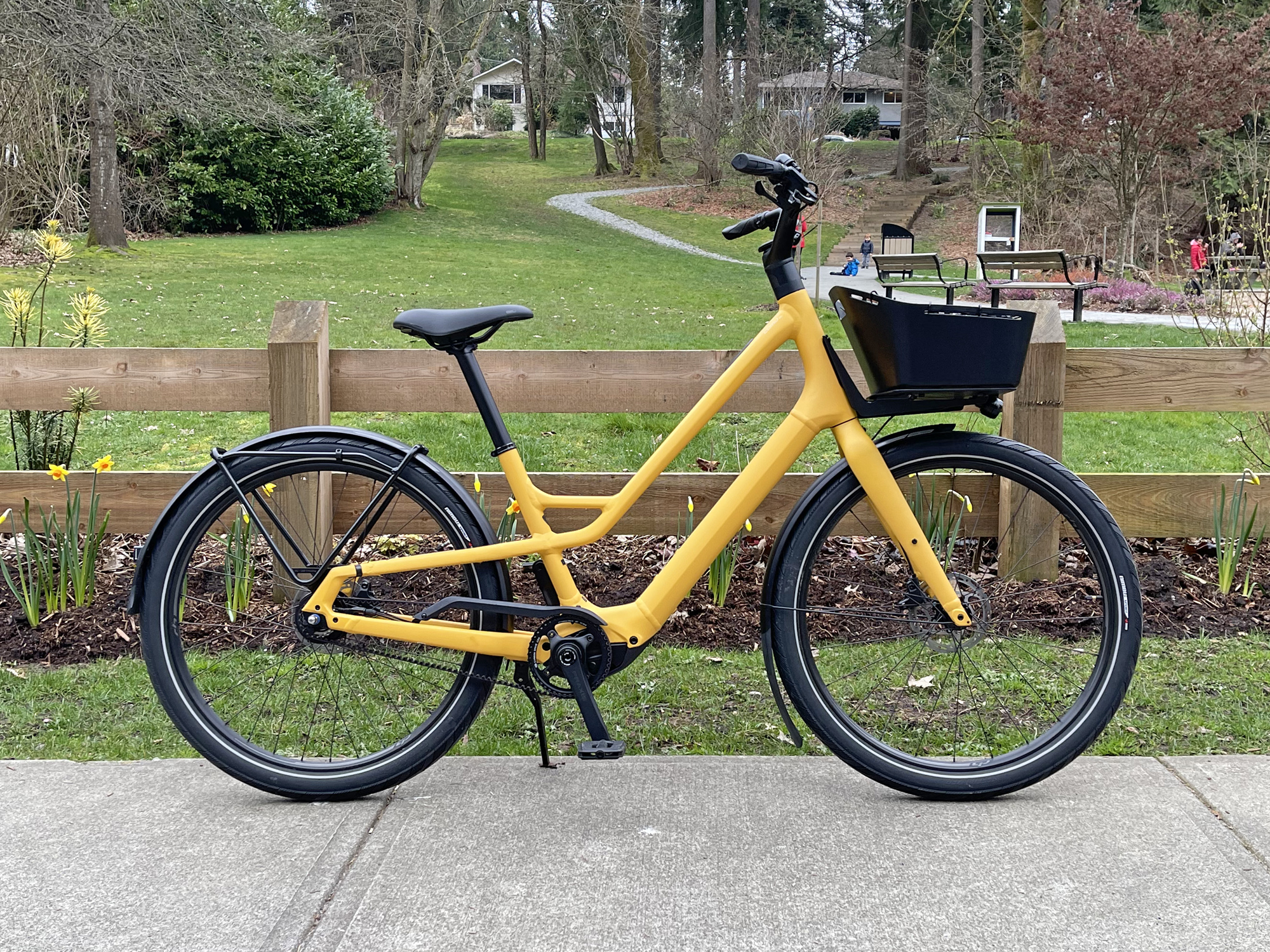
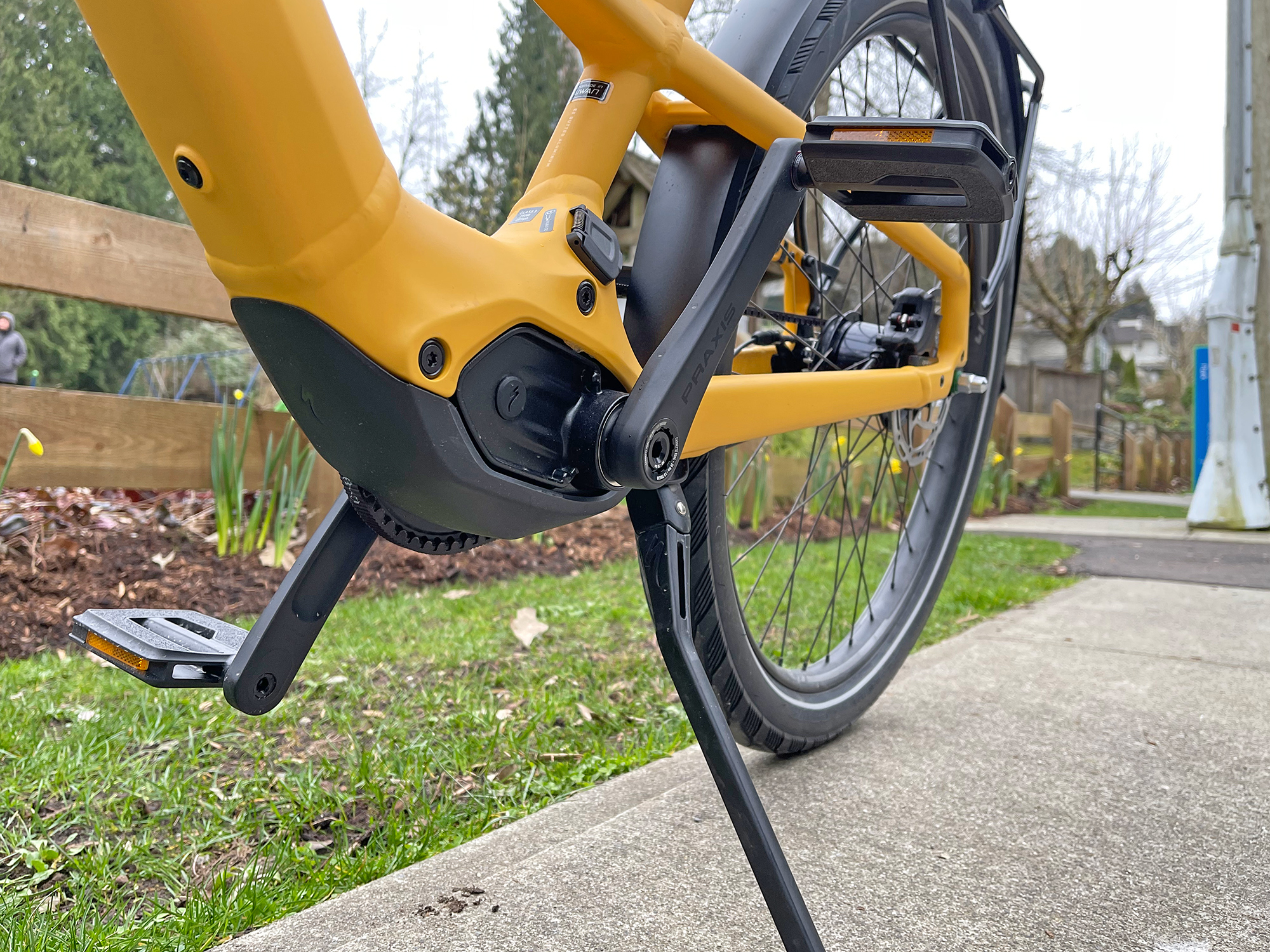
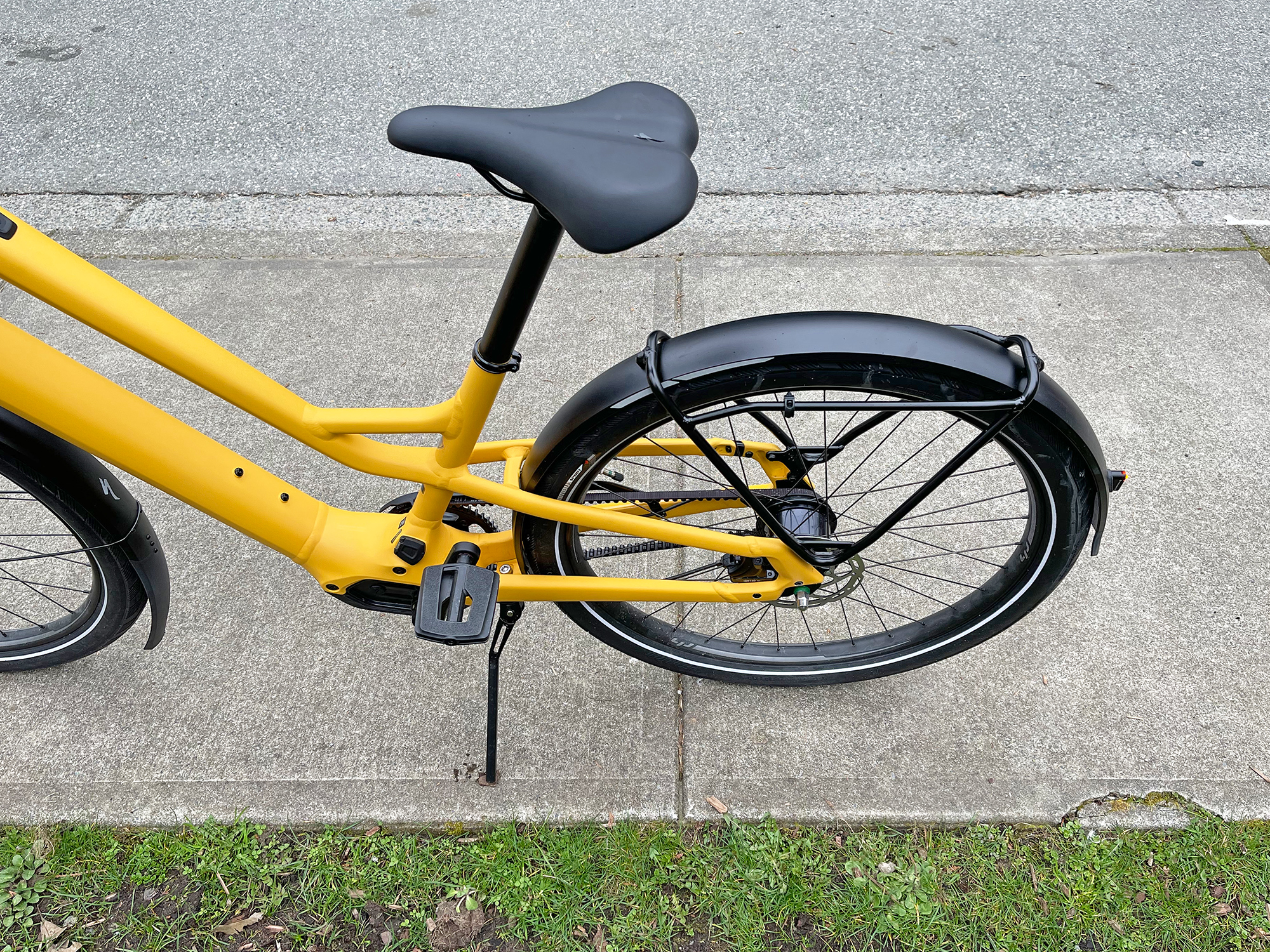

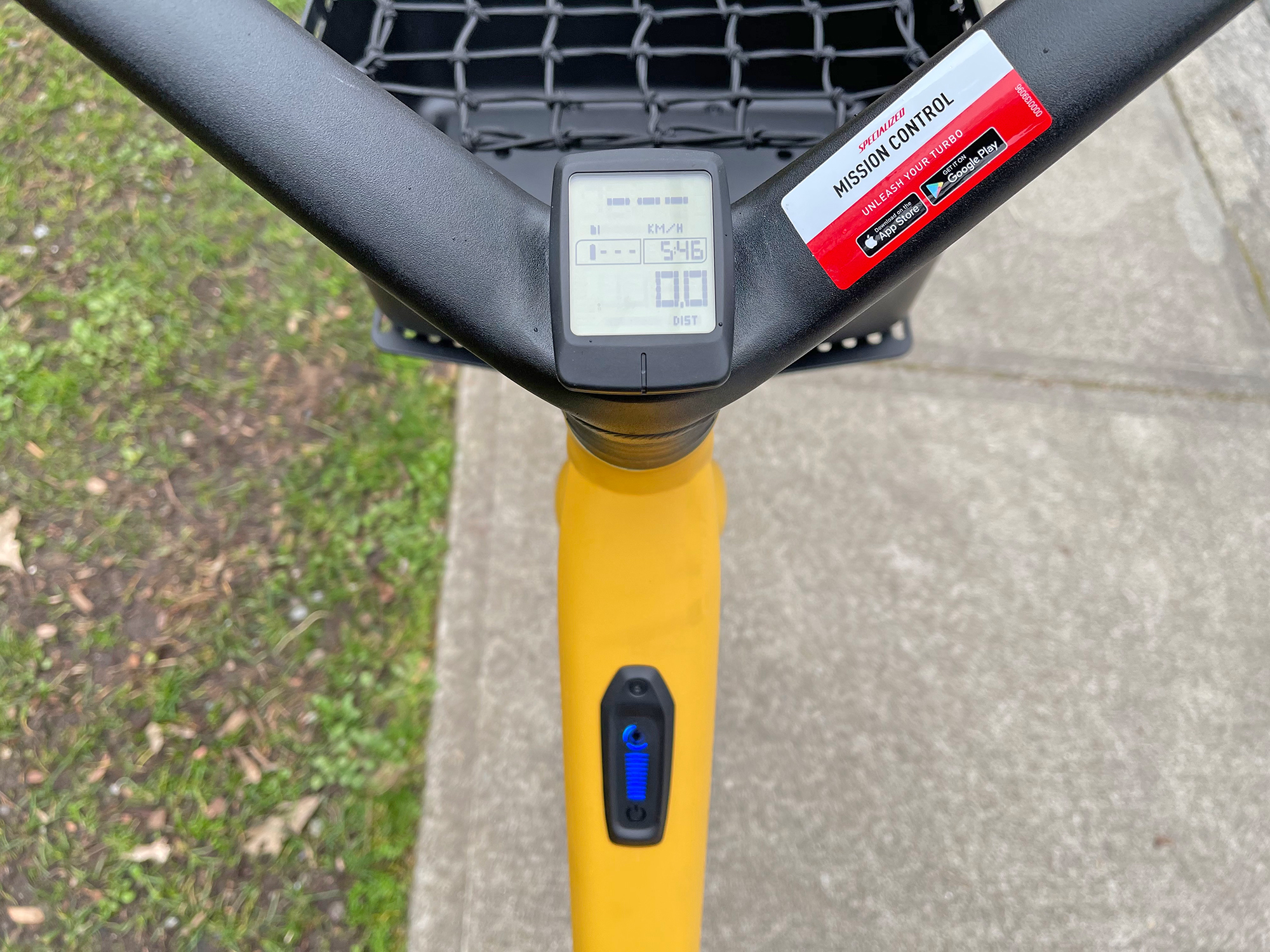
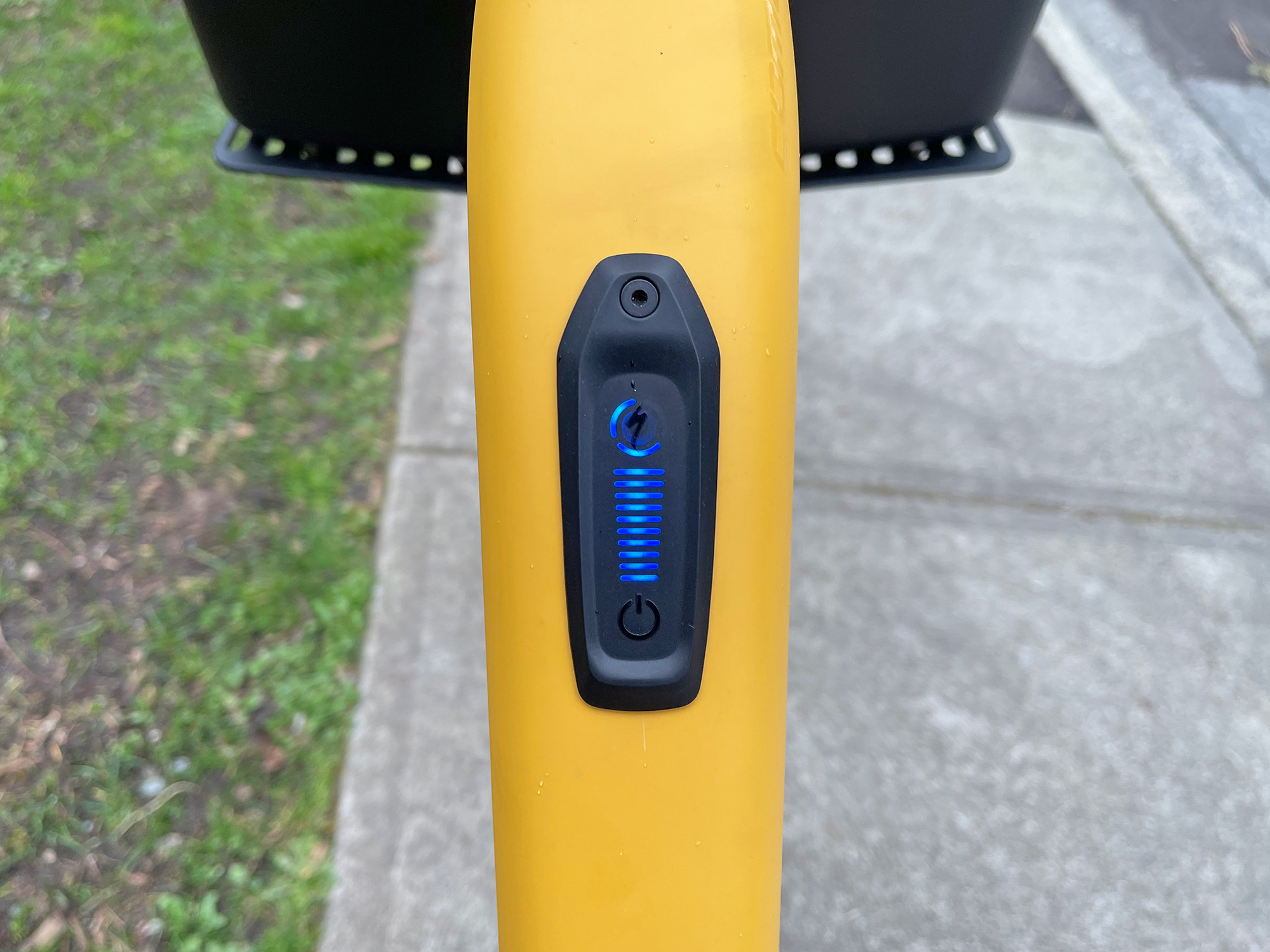
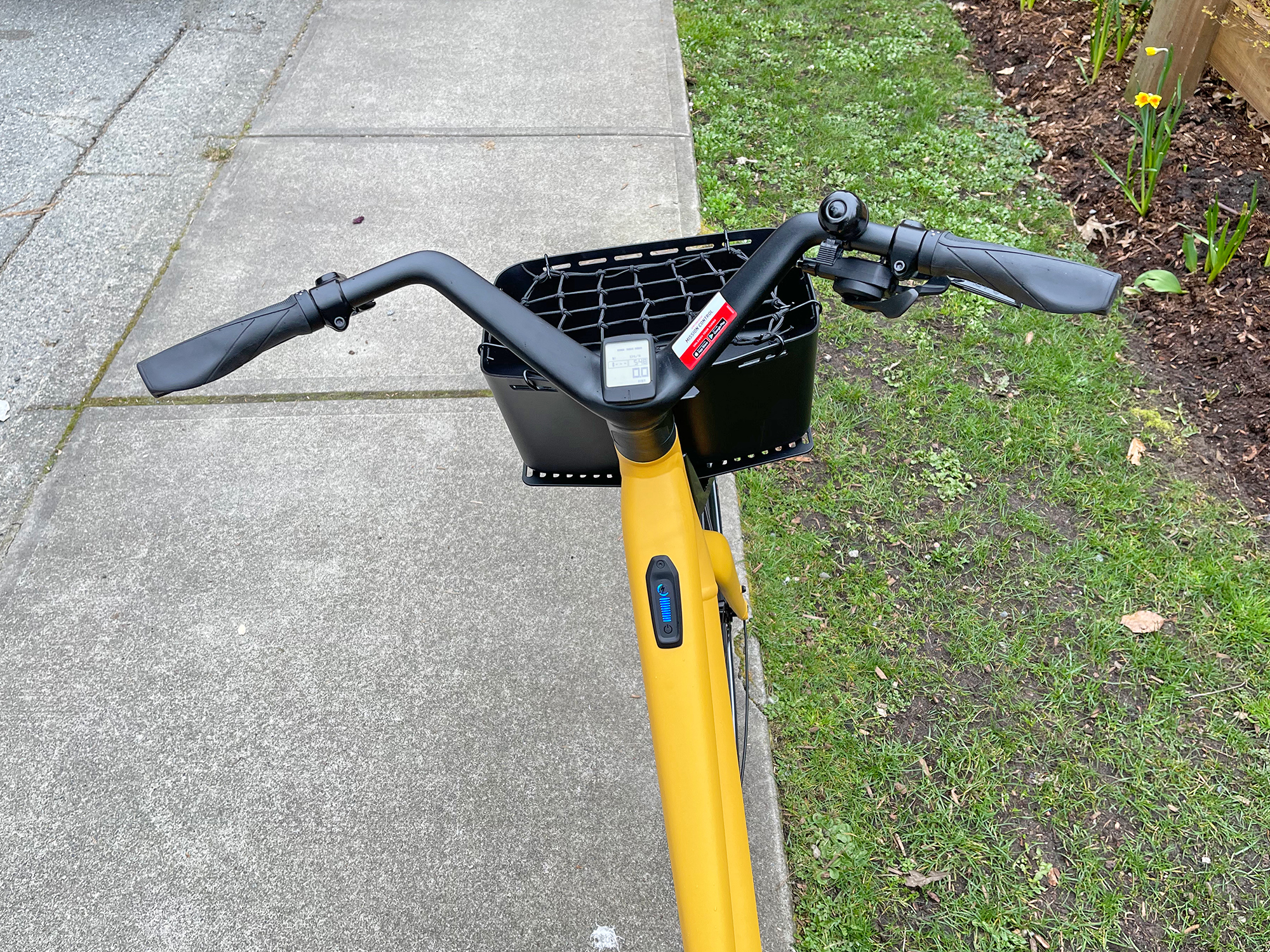
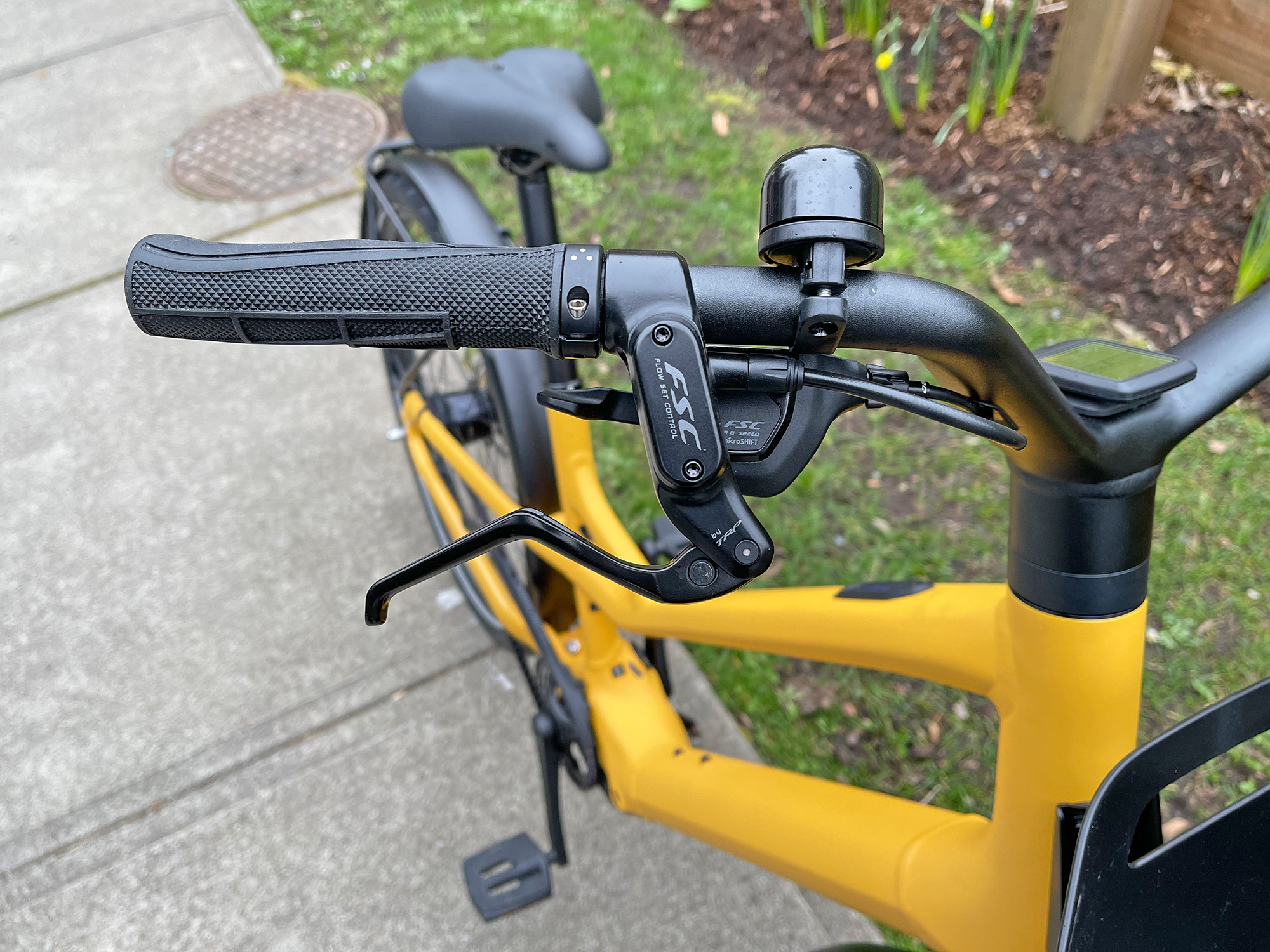

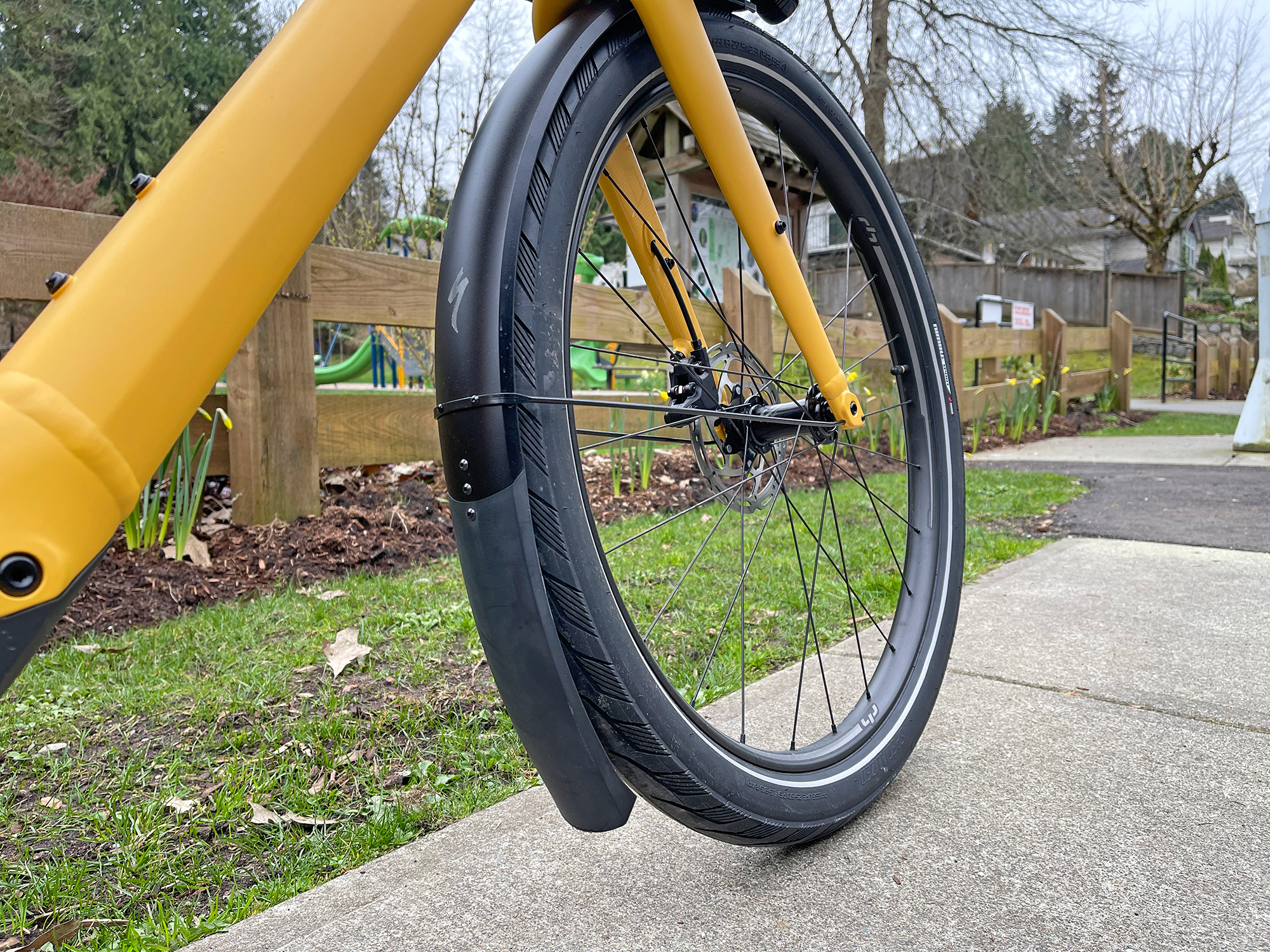
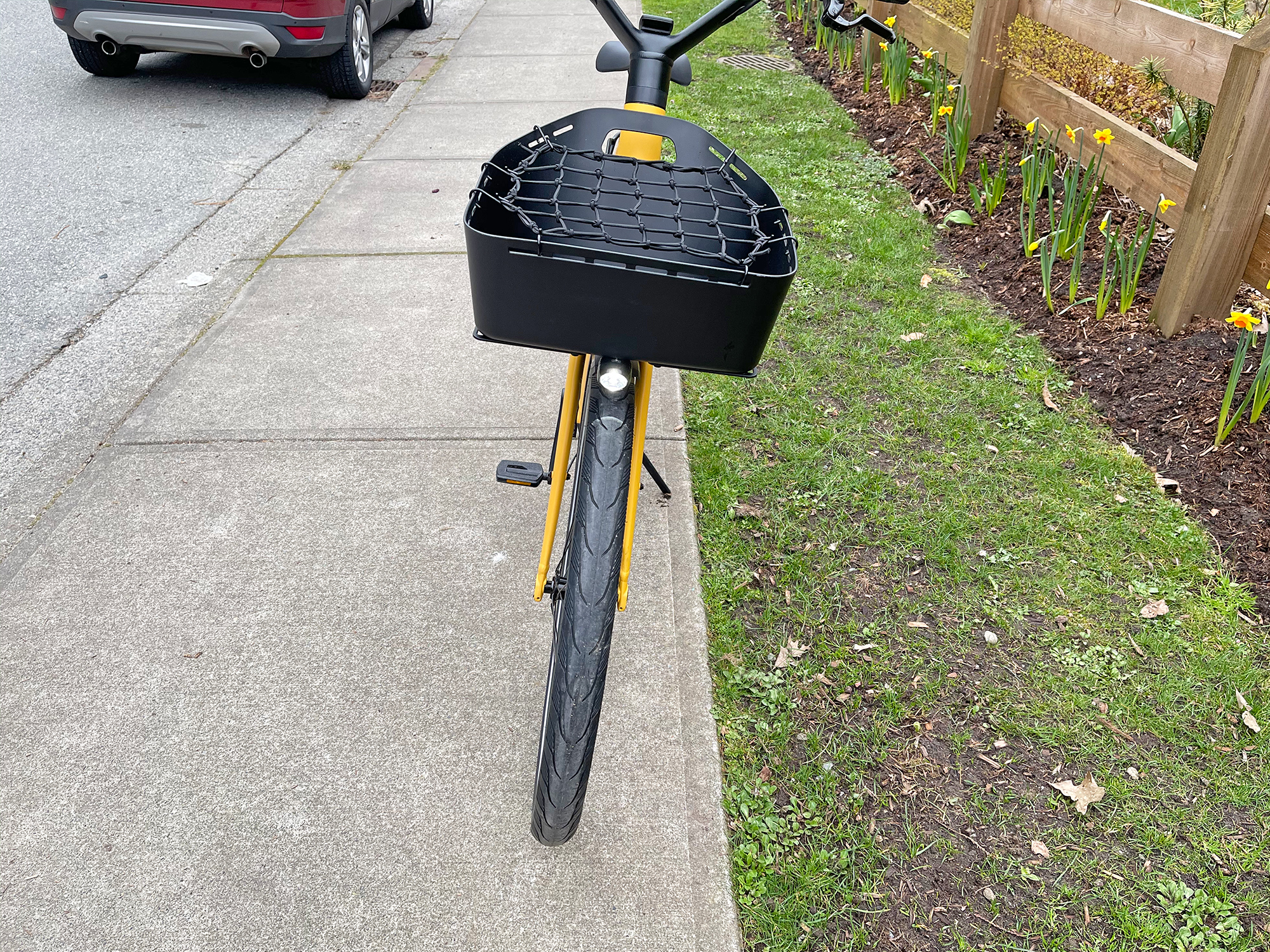
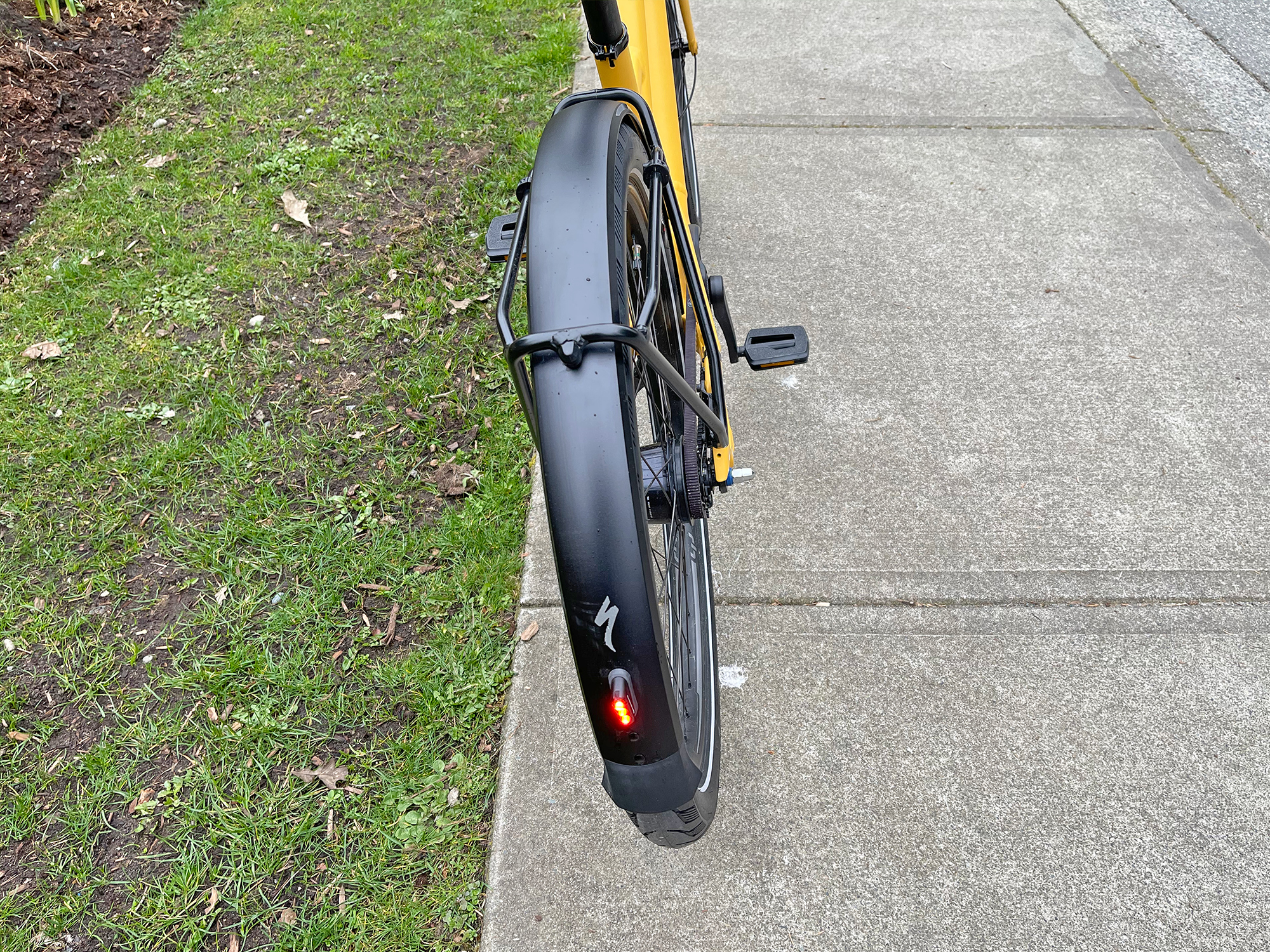



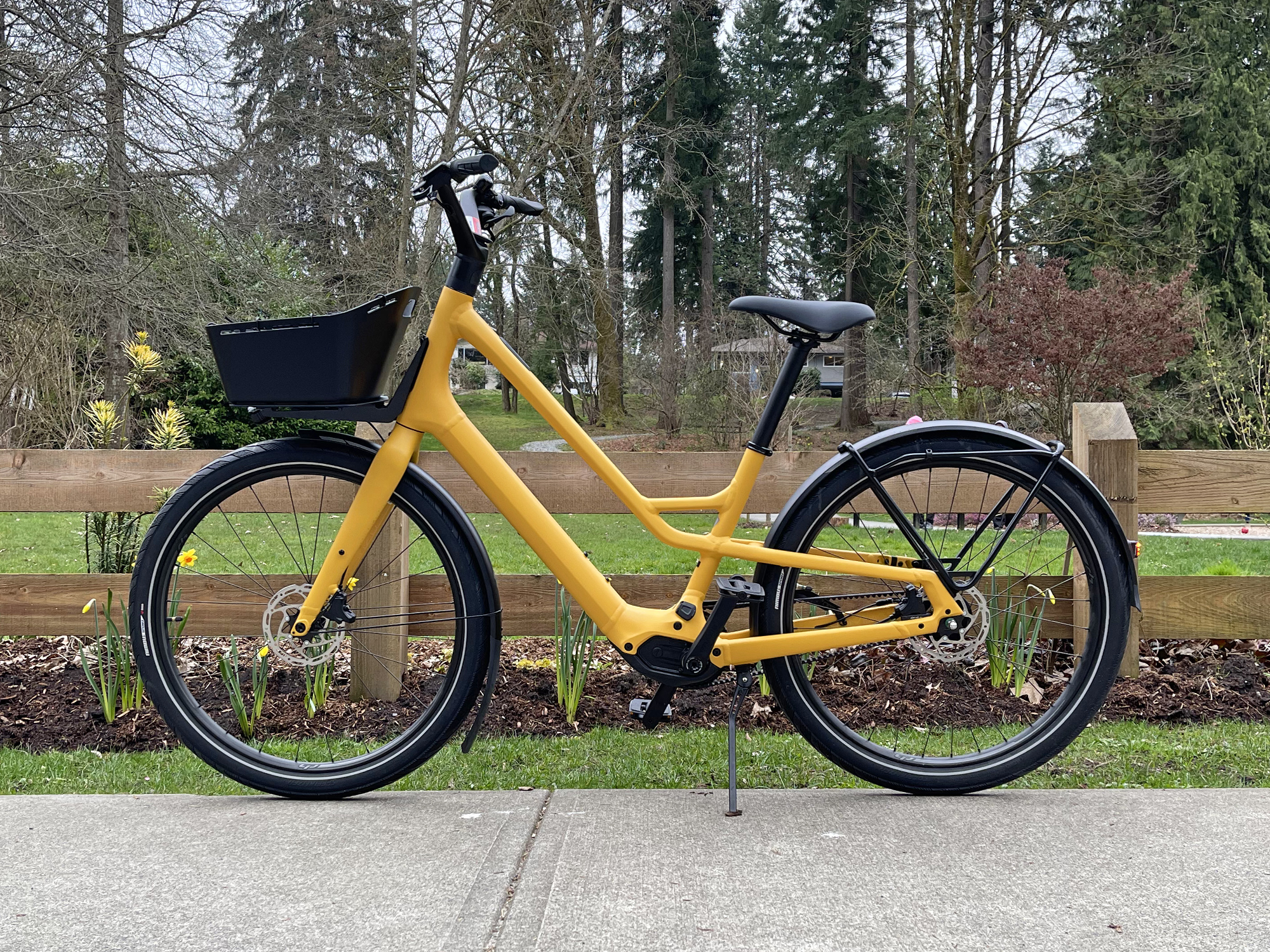
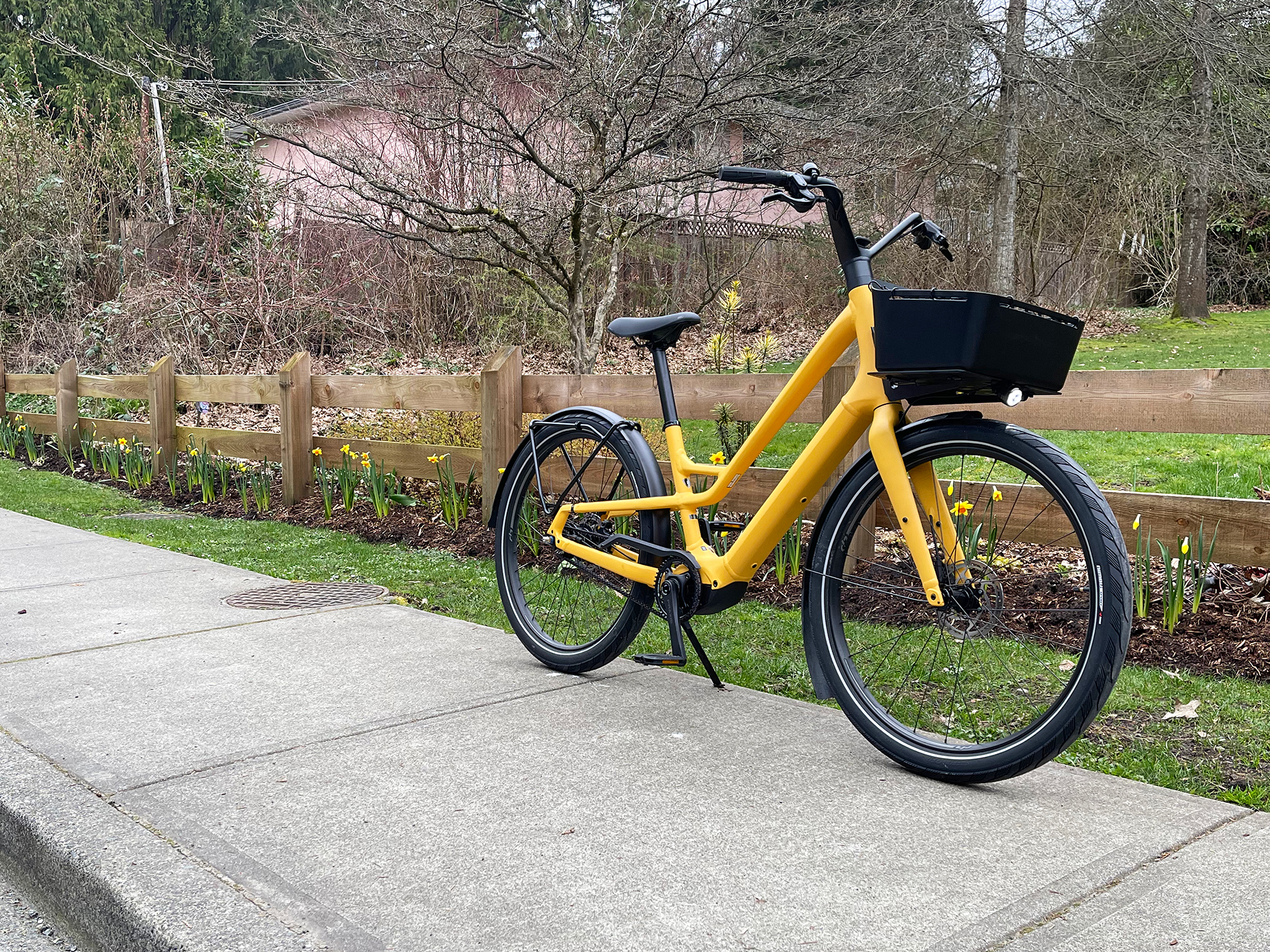
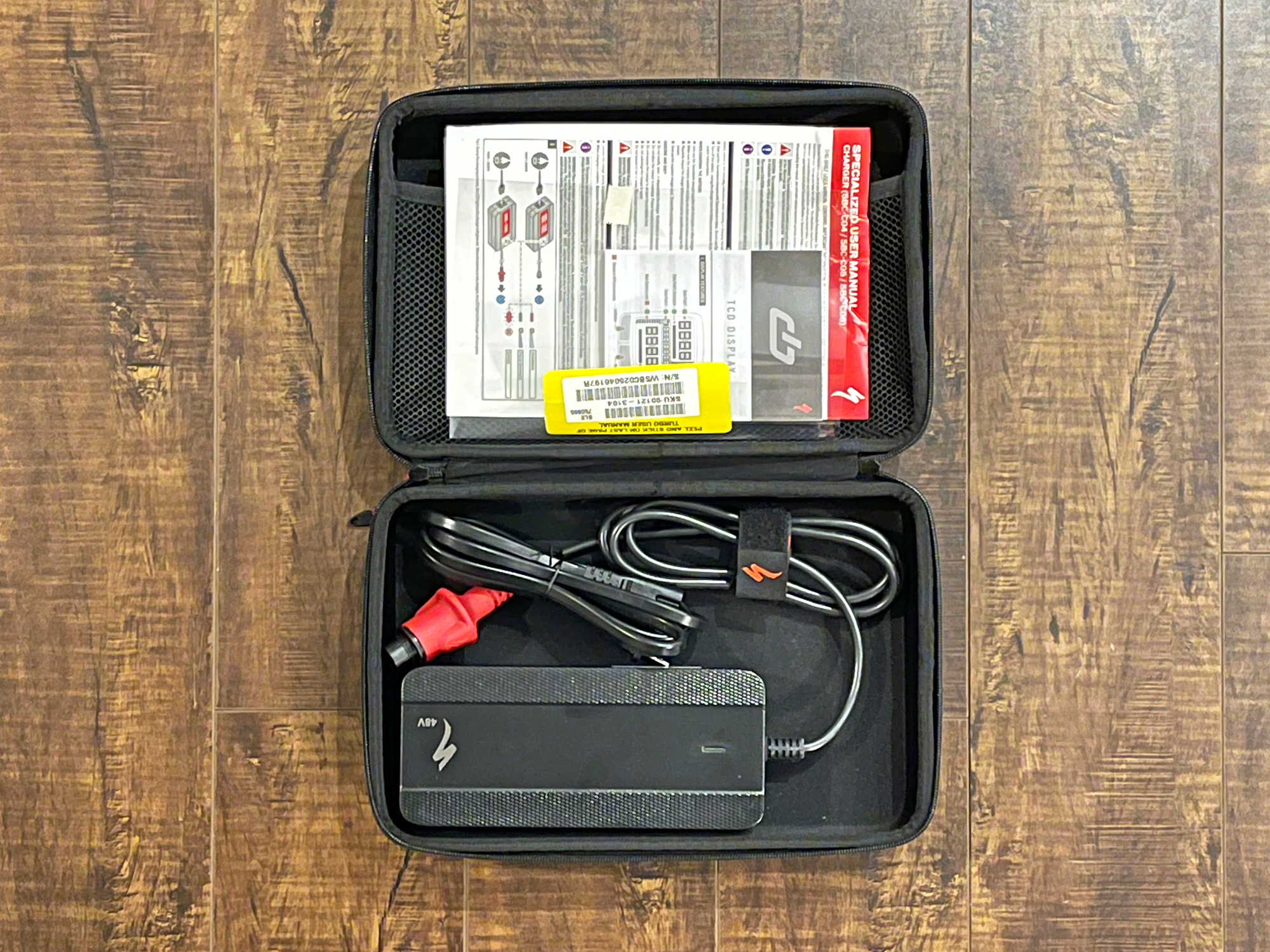
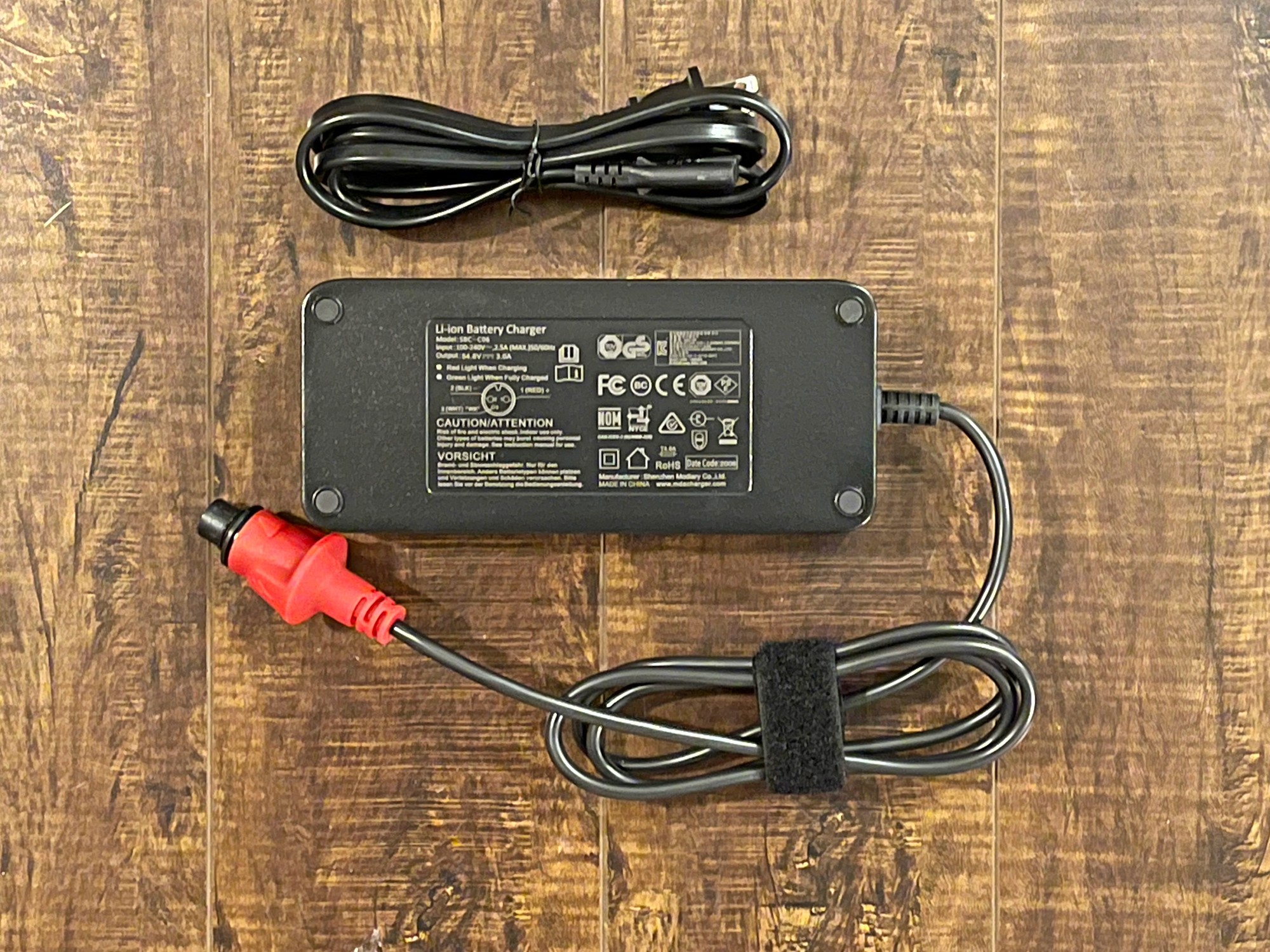

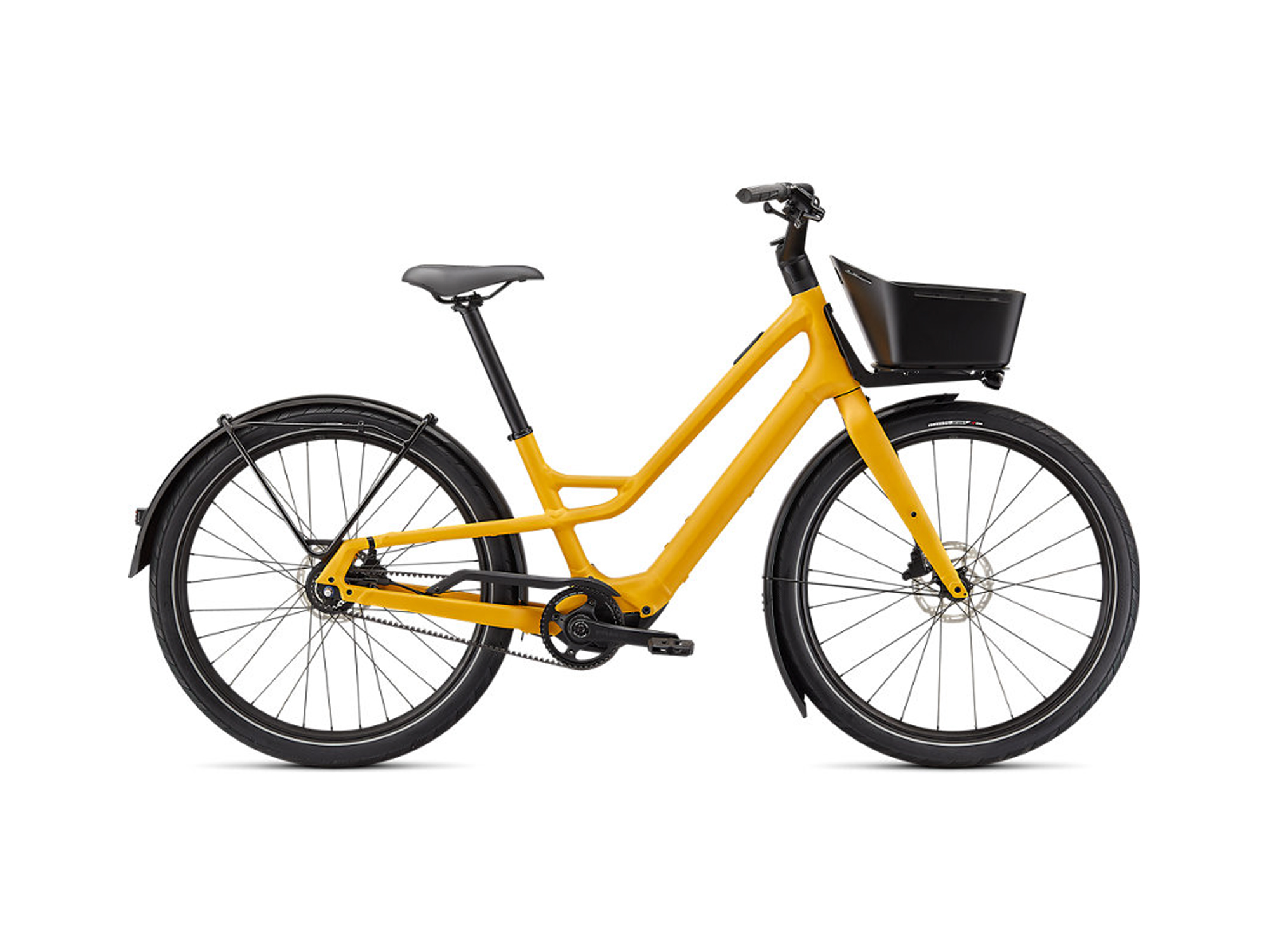

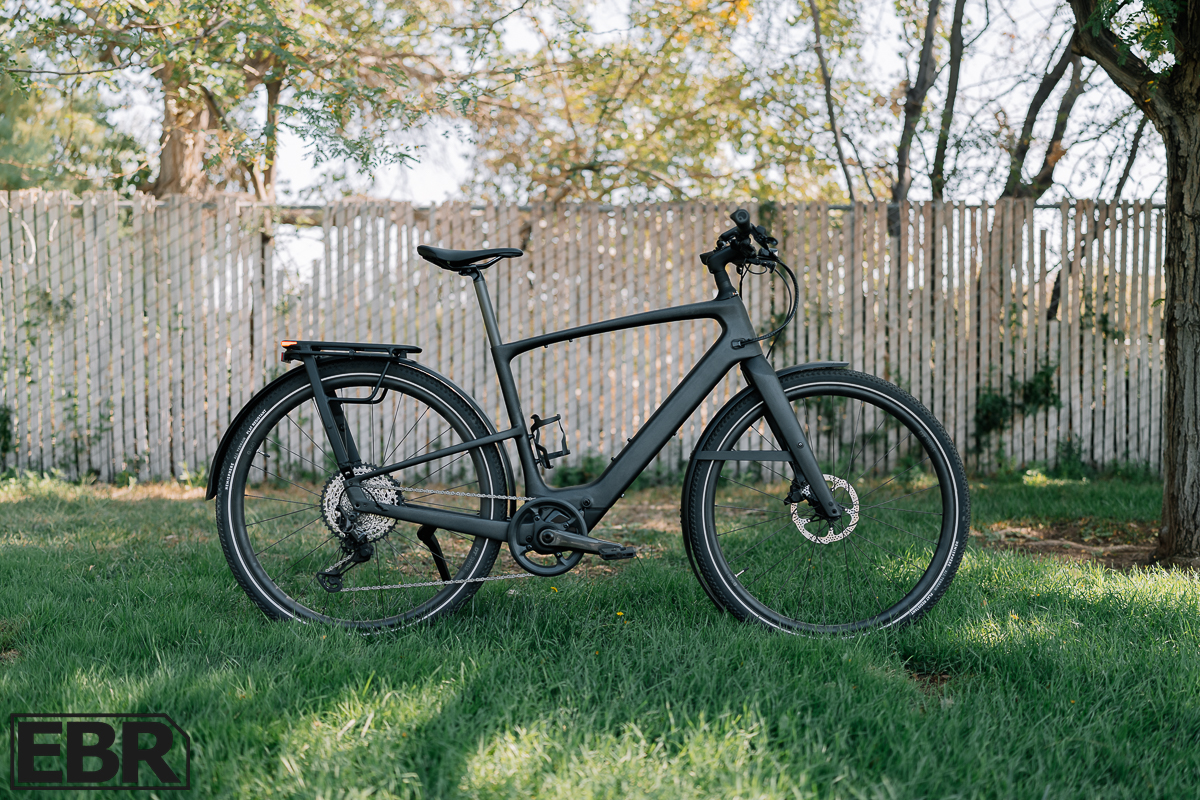
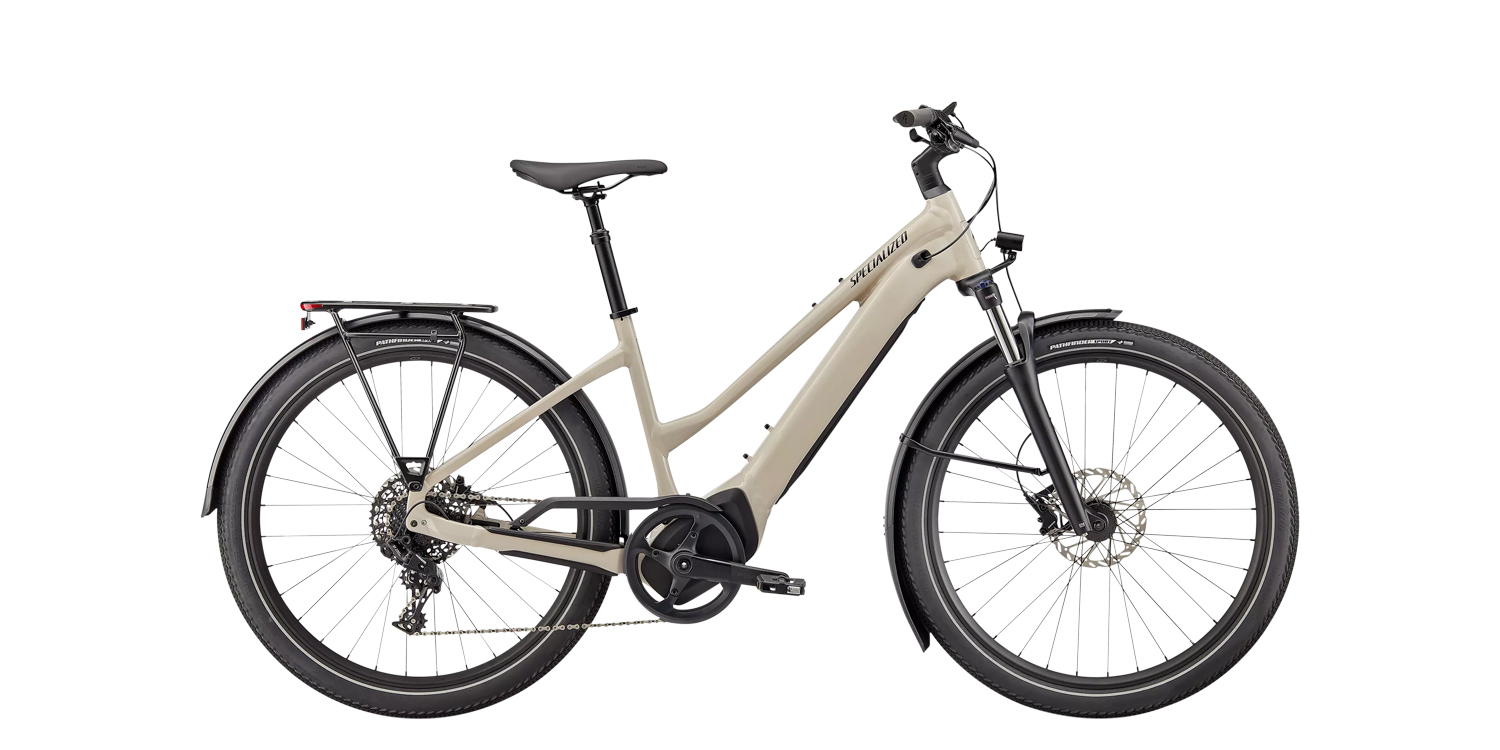
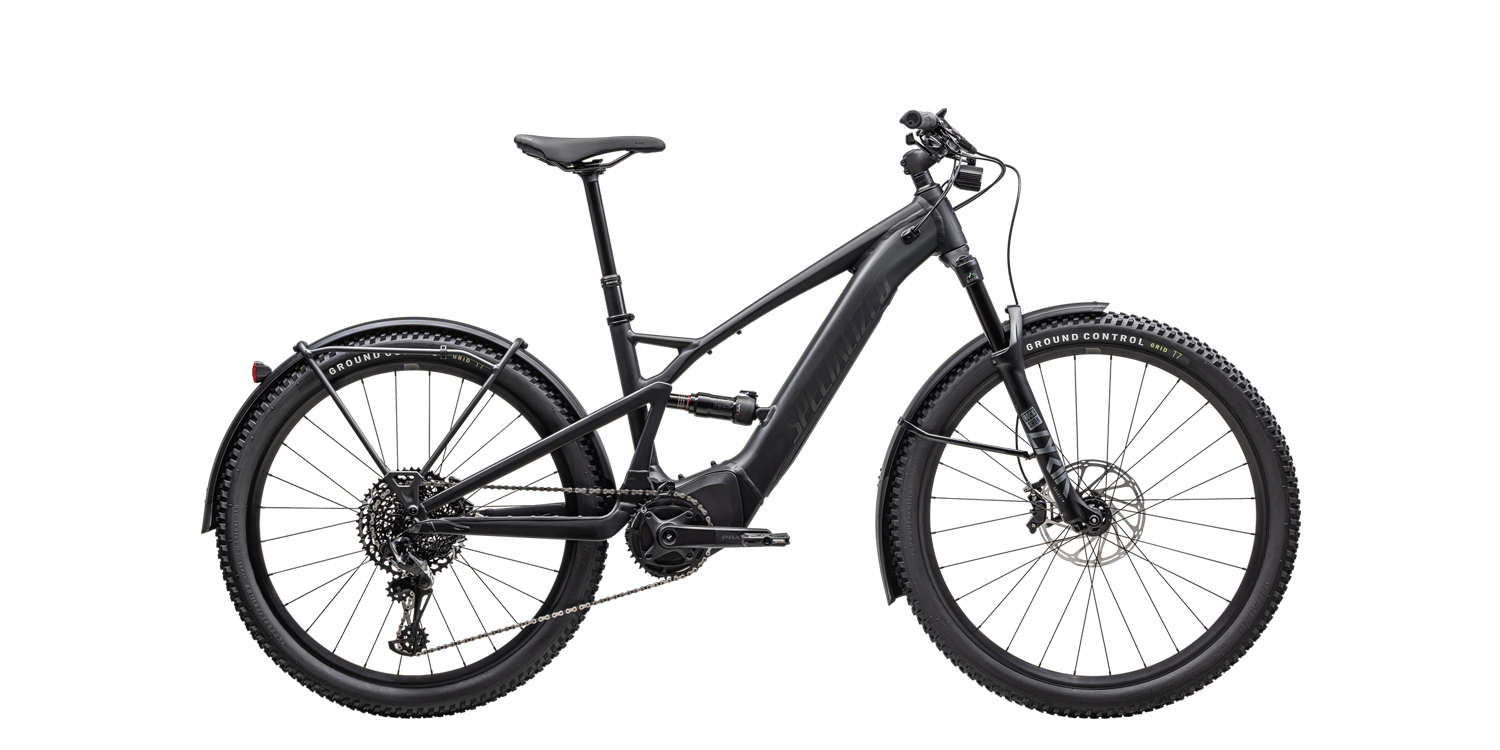
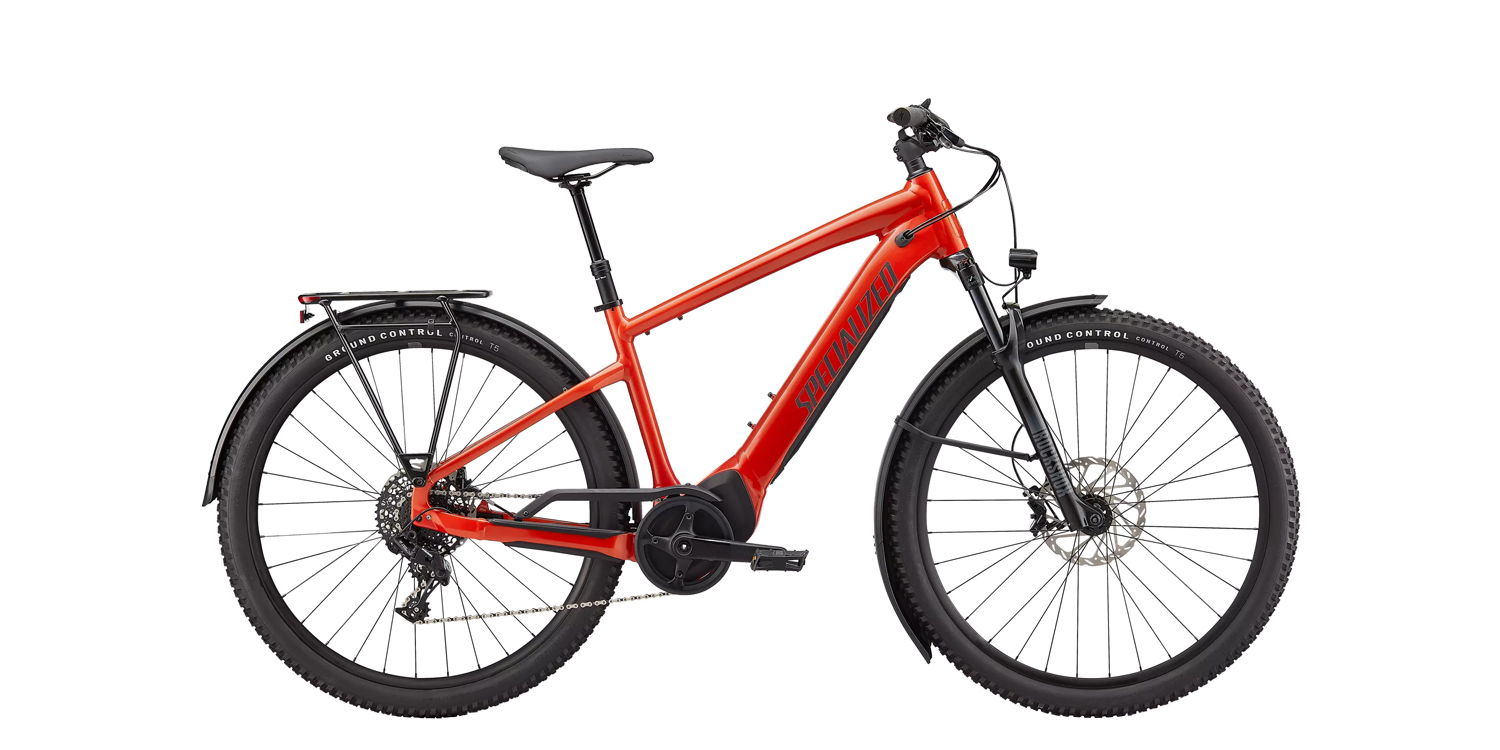
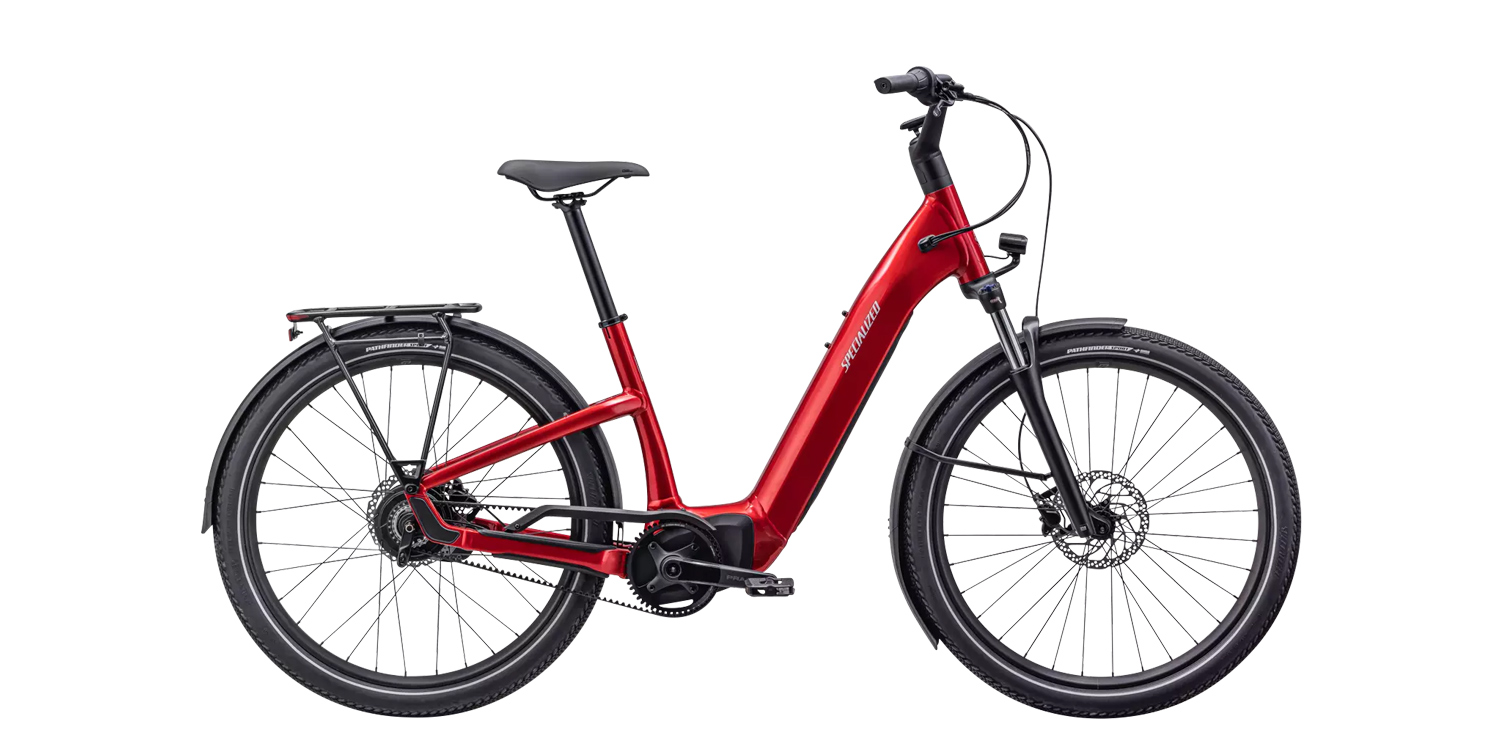
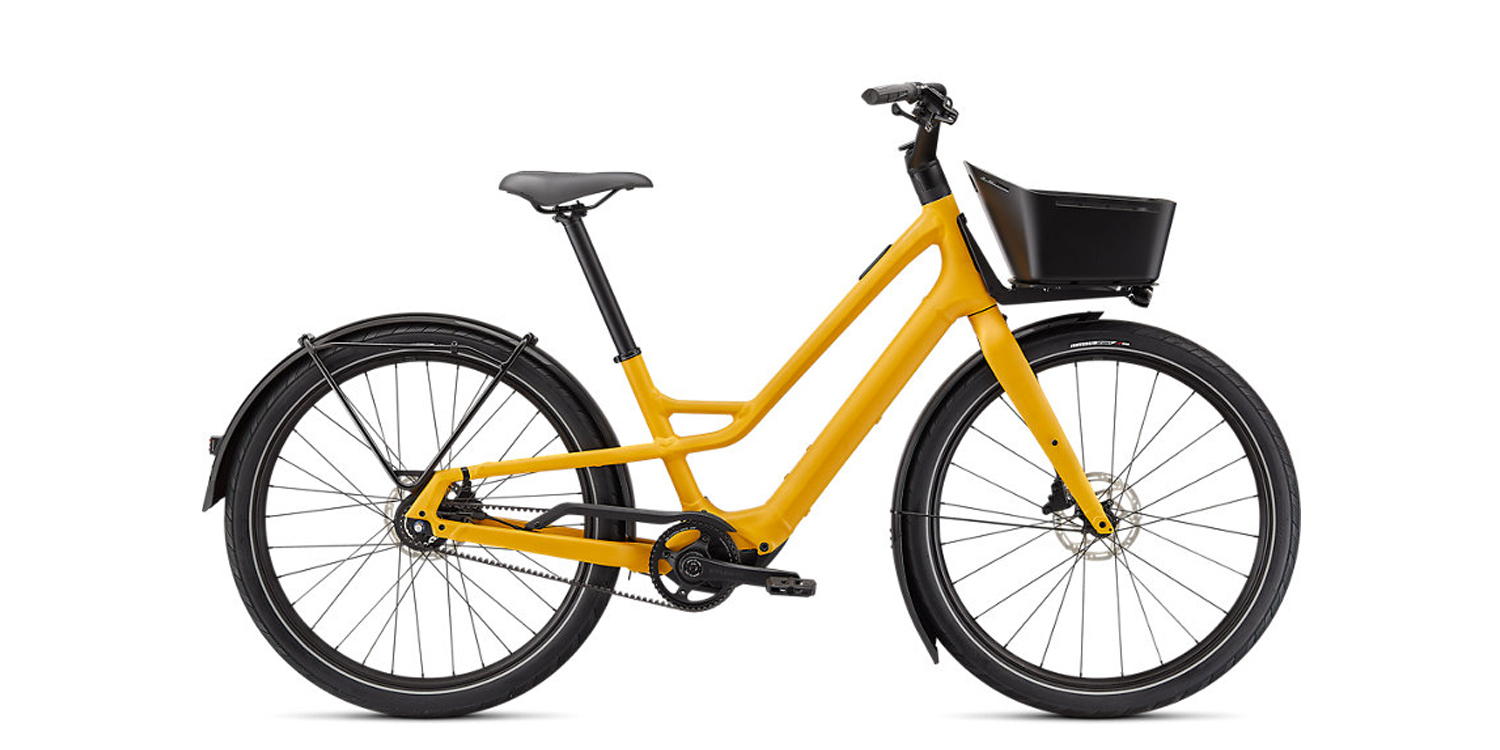
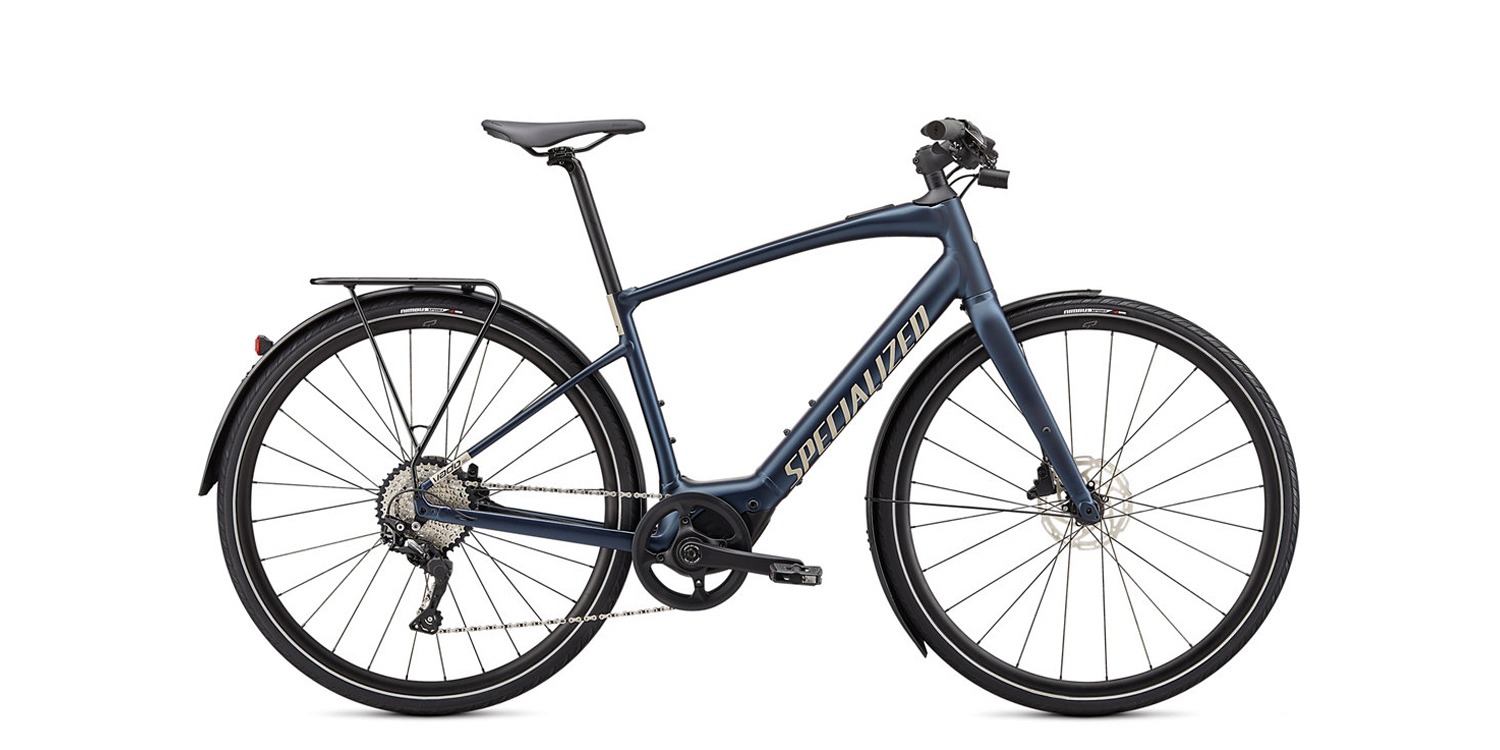
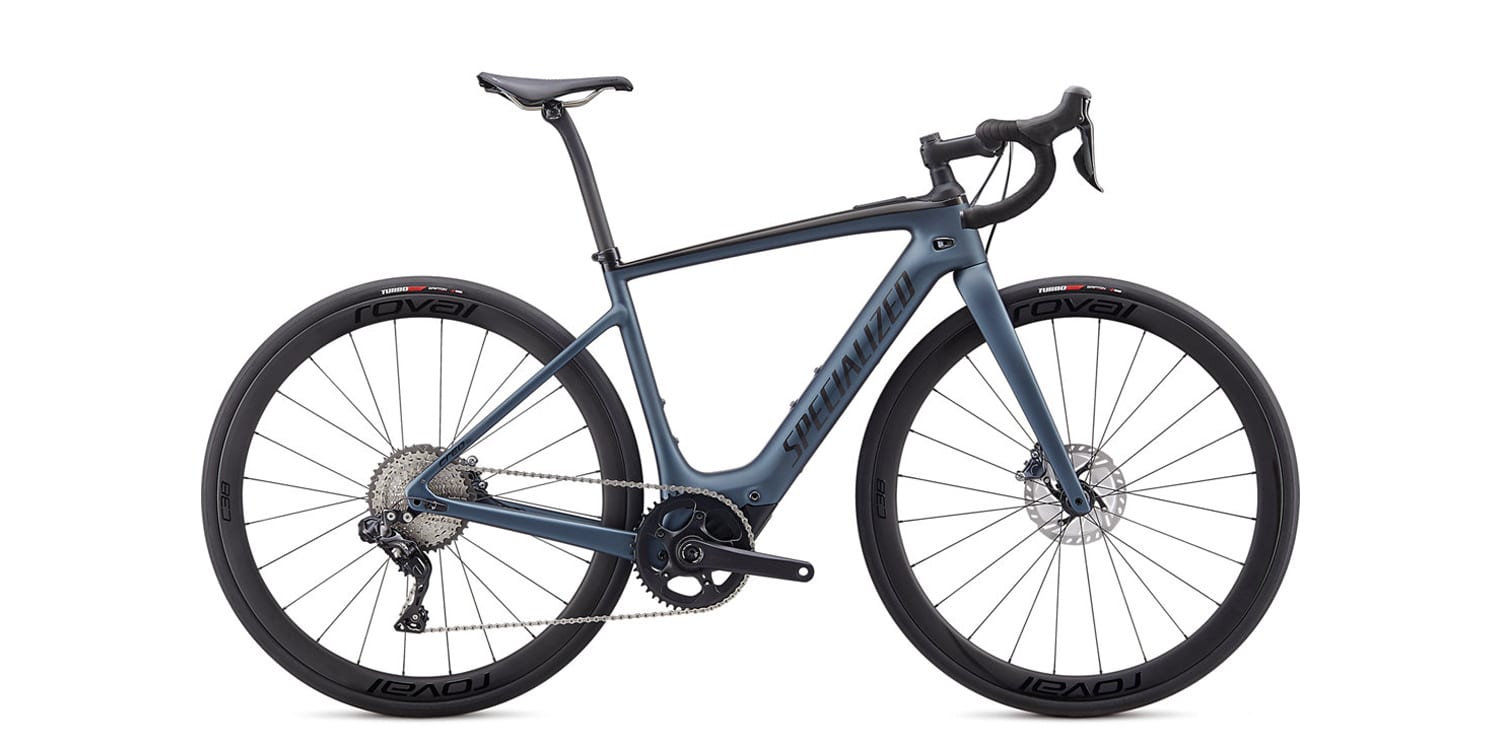
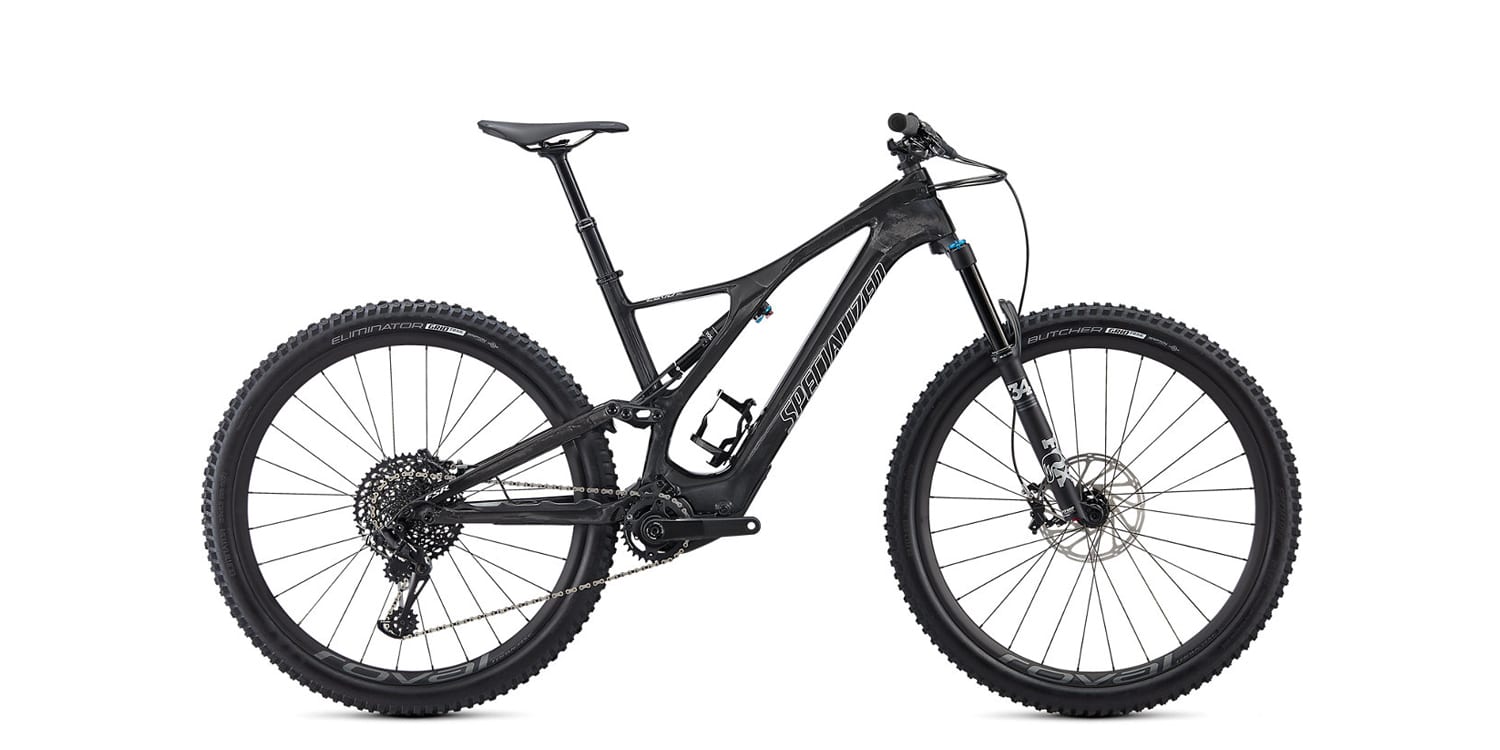
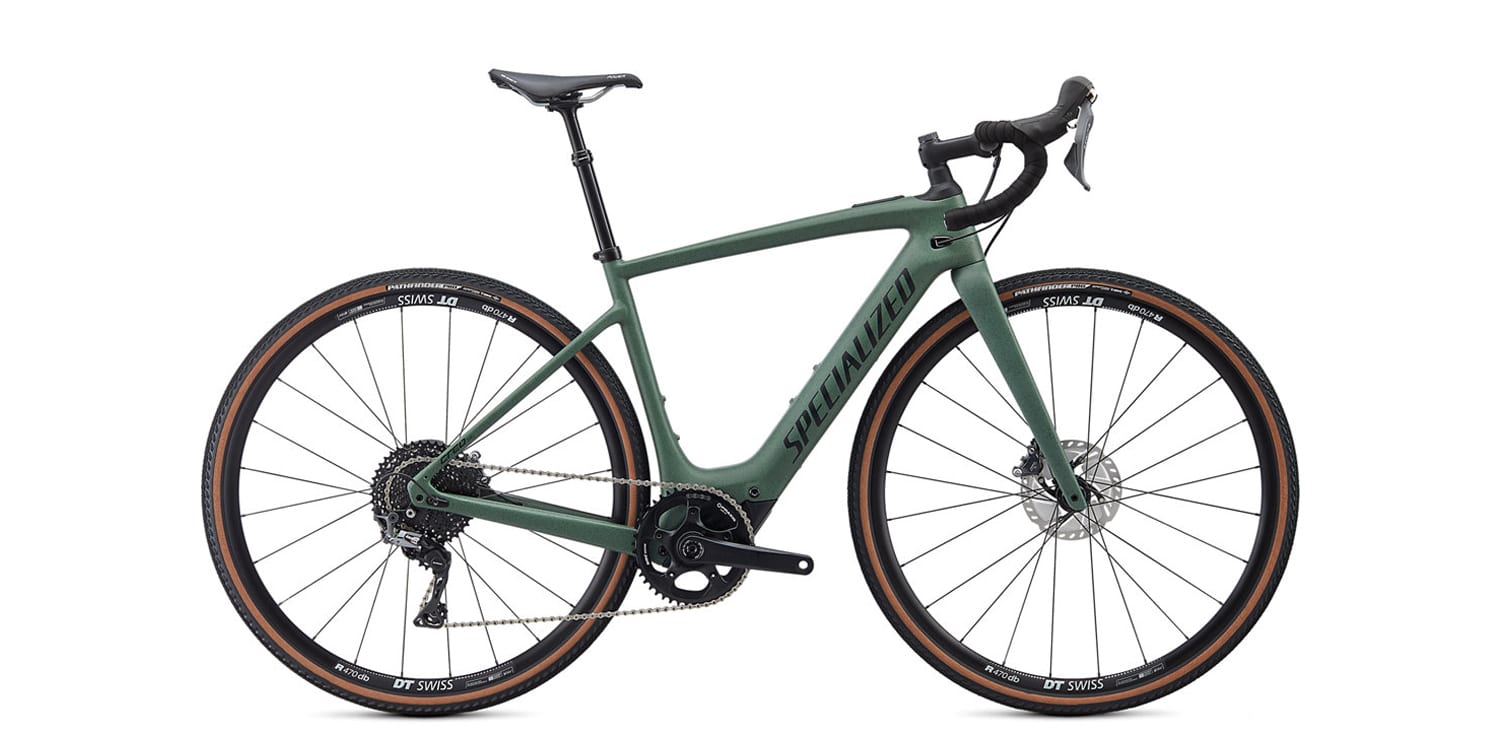
Marty says
Hi Court, thanks for the review. My wife bought a Benelli Classica in 2015 based on your review and still loves it. I have a few questions about the Como 5.0 SL. I’m getting older, now 72, am 5’8 and weigh 155 and am reasonably fit. I’ve been riding a Cannondale H400 24 speed and feel it is time to consider an e-bike. I’m attracted to the Como for its step-through and internally geared hub. My concern is if it is underpowered for our hills. We ride on country roads with a number of short but fairly steep hills. With the Cannondale I find myself slowing as I downshift to the lowest set of gears. I’ll make it to the top of each hill, but will struggle a bit to get there and often need to take a rest. In the video we didn’t really see Cheryl climbing the hill she arrived on. When she said she “went down two gears” does that mean she was in gear 6 of 8?
To get an idea of the hills we climb, my wife, who isn’t as fit, (hope she isn’t reading this), never needs to go beyond the second level of assist on the Benelli, never stands, and has no problems with getting up the hills. The Benelli is rated as a 350w motor (front hub) with max of 500 watts peak. Are you able to comment on how you think the Como would do in those situations. I still want to get a workout and break a sweat, but sometimes, towards the end of our 20 mile rides, I don’t want to work that hard.
Thanks,
Marty
Court says
Hi Marty! Great explanation. You and I are similar height and weight… and I find the smaller “super light” motor on this Turbo Como SL model to be very adequate. In fact, it’s the same one they use on the road, city, and full suspension mountain bike model which you can see here. You may want or need to shift down when climbing medium and steep hills (depending on how much speed you have going in and how hard you wish to pedal), but it should make it. Yes, if you shift down several gears and end up in the first or second gear, the bike will slow down a lot… but that gives you and the motor a mechanical advantage. It’s a big advantage in terms of efficiency and power compared to a hub motor which really only has one “gear” which is the size of the wheel that it’s spoked into. Given that your wife is doing fine with a 350 watt internally geared hub motor, and that you do enjoy a bit of exercise, I feel that this SL model, or the Vado, would be perfect. The Vado SL is just more upright in terms of body positioning. You could opt for the heavier, higher powered standard Turbo Como (which uses the Brose motor and has a removable downtube battery) but it weighs ~5lbs more without fenders or racks. Finally, to answer your question about Cheryl and here gear shifting comment… I’m guessing that she was in the middle gear, gear 4 (out of 8), when starting out. She might have felt the bike losing speed as the hill progressed… so she shifted down to gear 2 or 3 (shifting down two levels) closer the the largest “first” ring in the rear cassette or lowest gear ratio in this internally geared hub. Basically, gear 1 is the lowest, easiest, slowest, and gear 8 is the highest, hardest, fastest. Hope that helps ;)
Marty says
Hi Court,
Your comments are very helpful and appreciated. The Specialized dealer near me has his own Vado SL that I can test ride – doesn’t have the Como 5.0 SL in stock yet. The Vado SL is about 10 lbs lighter than the Como SL. Would that 10 lb difference still allow me to get a good feel for how the SL-1 motor would perform on the Como 5.0 SL? Or would that be like comparing “apples” to “oranges”? I really like the idea of the internal gear hub which isn’t available on the Vado SL.
Thanks,
Marty
Court says
Hi Marty, I do think there will be a tiny bit of difference in terms of efficiency when going from the narrower road tires and lighter all-carbon frame (depending on the model he has) and that 10lbs… but imagine if you weighed 10lbs more, it’s not really that much difference in the scheme of things… like 5% increase in weight? In practice, I think the bikes will perform similarly for neighborhood and city riding. The big drawback is lifting onto bike racks, shouldering and carrying, and if you choose to hit some jumps and tweak the bike mid-air! Hope the test ride goes well!!
saigonke says
I think with the cost of the bike at this moment is too high with the Vietnam economy. Thanks
Jim Hansen says
I recently purchased this bike online, sight unseen, and am having serious buyers remorse.
Considering the price, it seems unforgivable to me that the bikes mode has to be changed by looking down at the down tube. This is dangerous, and a serious downgrade from the previous Como 4.0 (which I also own). The TCU display on the newer, more expensive 5.0 SL is a downgrade over the TCD-W display, with a remote for changing modes (this came on the previous Como 4.0).
I see that the TCD-W display can be purchased separately (currently unavailable of course), but the shop where I picked up the bike just gave me a funny look when I asked if the TCD-W could be used on the 5.0 SL, and if they were even available to purchase. Even if it A) works, and B) can be purchased, there will still be the problem of where to run the wires from the remote down to the display. I suppose some vinyl tape and/or zip ties will be necessary to accommodate this (even if it will work).
I also detest the center mount kickstand, which I also consider a downgrade over the less expensive Como 4.0 model. The center mounted kickstand means no rolling the bike backwards, and because the kickstand is thin, it sinks into anything that isn’t concrete, making it functionally useless for many situations.
The front basket is a pain. It does come with a net, but it’s just big hard plastic box, and stuff bounces and rattles around in there. It’s also fixed to the head tube, which means it doesn’t turn with the handlebars. I find this disconcerting when riding (it obscures my view of the front wheel), and to make matters worse, the light being mounted to the underside of the basket means, your light keeps pointing straight when your wheel is turned. And lastly, if you remove the basket, it leaves nowhere to mount the light (and it can’t be removed without cutting wires).
The rear rack is a proprietary mount that holds the rear fender in place. It does not support mounting anything except side mounted panniers. If you want to mount a trunk style bag you would have to remove the existing mount and fender to do this.
Too much proprietary stuff, and too many things I consider to be downgrades for a $5k bike.
Court says
Excellent summary, Jim. I agree with everything you wrote, but want to point out that the steer tube mounted front baskets and racks can usually support more weight and won’t impact steering or slosh contents around the way that fork and handlebar mounted baskets and racks do. I tried to capture many of the same “considerations” in my review, but your comment is just excellent, especially with your insights from the alternative models. THANK YOU for sharing.
James Jay says
I agree with everything above. As an owner of a 2020 Como 5.0 model (Not an SL) and a 2020 Como 4.0, I feel the 2021 Como Sl is seriously downgraded from previous Como models. I feel a lot of online reviewers blow off the small size of the battery and exaggerate the real mileage the Como 5.0 Sl will really achieve. Small battery, no suspension fork, stupid plastic front basket and Specialized added an extra $600.00 dollar to the price. I’m would have already purchased a Dost if their ebikes had used a torque sensor. Sorry to vent.
Court says
Hey James! No worries, I appreciate your directness and agree with your insights. My goal with reviews it to be objective but also constructive and generally positive. I realize that can downplay some of the negatives for each bike, but I feel happier and it makes the channel more positive for people who are okay with the limitations and want to feel good about their choices. I do feel that the SL models present many trade-offs, especially since range extender batteries cost a lot and have been out of stock for some time. Perhaps we will see some improvements in the DOST pedal assist eventually, but right now many brands are out of stock and raising prices, so it’s more of a supply chain “survive” moment.
Donna says
Hi Court,
I am about to purchase my first ebike and at 51 and have really not ridden a lot since I was young. I recently rode an ebike on a great trail in NZ and we have amazing trails all around me. For the most part they are purpose built cycle trails and they are about to put a new one in front of our rural property on a gorgeous river! All of this along with a need and motivation to improve my health and fitness. We also live on a dirt road for around 2km or more so I won’t be zipping around a city!
Having said all of that, I have looked at a few bikes (there are big supply issues around at the moment!). I have come down to the turbo como 4 and the trek allant 7 e+. I nervous about pulling the trigger on such a large investment and want to get as much info as possible before I do!
I have an autoimmune disease which can cause inflammation in my joints and have some ongoing back pain which is somewhat related. When I sat on the Como I immediately felt comfortable and on the ride around the car park I was feeling great and secure! I haven’t been able to ride the allant yet but have sat on it. It did feel ok, but not as upright as the como.
All up, I guess the things I am nervous about are – the lack of suspension in the como even though it felt more comfortable. I am unlikely (I think anyway!) to want to get into any real off-road stuff, but also won’t be using it on tar sealed roads very often.
I will mention that the shop selling the como has put some buttons on the handlebars to allow easy increase and decrease on the motor and also said they would put the display on it for me for the same price. He is also closer to me.
I have a Tech background and am very happy with what the app seems to do and believe I would use it a lot. I also wanted to thank you for the review and discussion about the app. A lot of the other reviews just said it was available and didn’t seem impressed so I was glad I read yours!
Court says
Hi Donna! How awesome that they are expanding the trails nearby. Sounds like you’re in a great spot, regardless of the bike you choose. I personally loved the Como SL model and agree that Specialized does a great job with their “Body Geometry” frames and touch points. The saddle in particular feels great on the Como. Trek is an excellent company, but they seem a bit more sporty. Their casual brand is called Electra, and they tend to offer more cruiser models like the Como here. It sounds like you have a very supportive Specialized dealer nearby, and that can be a wonderful benefit! Sure, the Como you’re looking at here doesn’t have a suspension fork… but the larger tires and body position go a long way for comfort, and save a lot of weight. Many of the cheaper suspension forks do not work that well even if they are present. You could swap the fork, try to find an air fork, and set it up perfectly… or just run the tires a bit lower pressure and add an adjustable suspension seatpost with a shim (ask your shop for help on that). I think that the bike will be fairly comfortable on pavement and even some gravel and dirt trails, and the Trek Allant may actually be similar even with the suspension fork, just based on the more aggressive geometry and saddle. Hope this helps, good luck and have fun!!
Donna says
Thank you so much for the reply Court! I think I am going to go in now and buy it! I really appreciate your time and quick reply!
Court says
Sure thing, Donna! Hope you enjoy the bike, perfect time of year to be getting out for some rides :D
Marty says
I am thinking about purchasing this bike once it is available. Does anyone know if the basket can be removed without also removing the tray it sits on?
Court says
Yes, I’m almost positive that the plastic bucket can be removed from the metal tray. If you look at the video around 4:09 you can see some circular holes in the bottom that provide access to bolts. I hope this helps and is accurate, but I think it is ;)
Marty says
That is what I thought from the video, but a comment above says, “And lastly, if you remove the basket, it leaves nowhere to mount the light (and it can’t be removed without cutting wires).” which has me concerned.
Court says
Hmm, looking at the pictures again here, it looks like there’s a metal rack, a flat piece, and then the basket on top. It appears that the light is mounted to that flat piece. Perhaps the other commenter (Jim Hansen) was thinking about removing all three pieces, so the rack system would be gone entirely. I wish I had one in front of me to confirm, but this is my best guess :D
Arhant says
Did you ever find an answer to what to do with the light if you remove the frame that the basket sits on?
Wayne says
I have a 2022 Como SL 5 and love it. I removed the basket (takes 2 minutes) and simply tie-wrapped the light back where it was… very clean look.
Court says
Nice! Thanks for the feedback and tips about how it worked when you removed the basket Wayne!
Cheryl says
I’m a seventy year old 5’2” female, and just purchased the Como SL 5.0. I find the ride incredibly smooth. It took just a few moments to adjust to easing off the pedals before shifting gears, but it quickly became second nature. I still feel indulgent using even the lowest gear assistance mode. It powers me up most hills, but I do use the second assistance mode just to experience the swiftness of the ebike ride. I’ve only used the third assistance mode to see how fast “we” could go. At a little over twenty mph I eased off-fearing I might actually take flight.
I took the basket/rack off the bike, and remounted the front light. The excess cord fit snuggly in the stem. Now the light actually turns with the steering motion of the bike. The large tires probably do make up for the bike not having seat or fork suspension, as I rode on gravel filled cement block type paving, without a bit of trouble, along with a friend who immediately dismounted her ebike saying she couldn’t ride over the rough surface. I initially didn’t want the larger tires, but will probably realize they do bring a level of comfort to my derriere at this stage in life.
I did not purchase the extended range battery pack, but with the long range I’m getting from the main battery, I figure I’d need to pull off to the side of the trail and take a nap before needing that extra range. Just as a personal preference, I would like to have been able to mount a rear slip on basket/carrier to the bike. And that little walk assist button would have been the icing on the cake. Also, just a cautionary note to any new ebike owners-especially when riding with another ebike rider-the hum of two different ebikes on an otherwise quiet road/trail is enough to make you think a vehicle is approaching from behind when it’s just the gentle sound of technology accompanying you on your ride. Happy trails!
Court says
I enjoyed your review and tips, thanks for sharing Cheryl!
KIKI AUBIN says
HI JUST WANTED TO KNOW IF THE MANUFACTURER STILL EXIST BECAUSE I AM BUYING SECOND HANDED,
Court says
Hi Kiki, yeah Specialized is definitely still in business! They have a bunch of shops and a great official website with more details here.
Chris says
Court and Cheryl – thanks for the great review! I love my Como SL.
I love the minimalism of the bike. No ugly numbered gear lever, no glaring logo on the down tube. The designers did a neat trick with no triangles at all in the frame, it’s instead an appealing set of trapezoids (trapezia?)! A side note on frames: it’s urban myth that steel frames are more forgiving than aluminum. Long chain stays (as on the Como SL), long seat posts (as on the Como SL – the medium allows for an almost 30.75” saddle to crank center max height!), and large tires (as on the Como SL) provide a relatively more infinite forgiving ride than an imagined difference in frame materials.
Someone was concerned that the downtube power switch was ‘unforgivable and dangerous’. That’s a concern only if the millions of ten-speed bikes built with downtime shifters for the last century were ‘unforgivable and dangerous’ – and respected trend-setting bike builders still build with those today! I again applaud the Specialized designers for the minimalist approach.
I removed the front rack and basket from the Como SL, which weigh a combined four pounds. We live along the dry Central California coast, and a full fender set is decadent, so I removed the front one, saving close to another pound. A final modification was to replace the (almost two pound each!) Nimbus tires for lighter and more supple tires, saving another pound and a half. A whopping $70 investment, but those Panaracer 27.5” fat tires do more to absorb road ripple than any clumsy and heavy suspension fork!
With those few changes, my size medium Como SL is now only two pounds heavier than my wife’s size medium Vado SL EQ – and I’ve got the cushier ride!
Like I said, I love my Como SL!
Court says
Great feedback Chris, thanks for sharing your experience with the bike, and your enthusiasm for the review :D I don’t see the downtube power button as dangerous, but it is less convenient to reach than a control pad near the grips. Perhaps it reduces tampering with the display, or helps the battery avoid phantom power draw since it could be directly interfacing with the pack vs. along a cable. I’m a fan of minimalism too, thanks for updating us on how much the front rack and basket weighed! The tire swap sounds good, did you choose the Panaracer GravelKing 27.5 x 1.5″ (650B x 38) or some other model from them? Amazing how light these bikes can be… I’m a big fan of the SL line from Specialized :)
CHRIS says
Yes, Court, I chose the Panaracer GravelKing, more specifically the 27.5 x 1.9″ (650b x 48mm) SS (semi-slick) tires. To me, they absorb the bumps of chisel much better than the Nimbus, and the steering overall feels much lighter and a little livelier.
I need to make a correction: when I earlier posted the maximum seat height, that was with a (pricey) Berthoud saddle. With the stock Specialized saddle (also very nice, and which I may return to) the maximum seat height is 31 3/8″ (79.7cm). That should accommodate someone with as much as a 35″ (89cm) pubic bone height, or something like a 34″ inseam! I’m six foot tall, and am pleasantly surprised how comfortable I am on my medium Como SL, and how similar it is in overall dimension to my previously 2022 Trek FX 2 bike.
Court says
Thanks for the details CHRIS! It sounds like you’re happy with the bike, and it’s interesting to hear how you’ve personalized it. Very detailed, thanks a lot :D
Herman says
What size is right for me L Or M? I am 178,5 cm and my inside leg lenght is 79.5 cm.
Thank you!
Court says
Hi Herman! We are very similar, I’m 5’9″ tall. Shops often tell me that I could fit a Medium or Large, but I tend to go for Medium to reduce weight and feel more in control of the bike. Since you are slightly shorter than me, I would say Medium :)